When I was in Junior
High School, back in 1961, I went to the "Silent Movie
Theater", at 611 North Fairfax Avenue, in Los Angels, You probably know this building. It was used by
Producer-Director William Castle for his 1959 horror-thriller starring Vincent Price, "The Tingler".

Above the movie theater
as I knew it,
What I watched was the
55-minute, 16 mm, "Kodascoper", cut of the 1925 version of "Sir
Arthur Conan Doyle's The Lost World". The original release ran either
106, or 108 minutes, but what I saw was the only known version in North America
at that time. Since then more footage, from the Czech Republic, has been
discovered. I now own the 93-minute version from 2001. However, more footage was
apparently found in France. In 2017, what is considered the complete version at
110 minutes, was released on Blu-ray.
This is the story behind
that motion picture and the two men who brought "Professor George
Edward Challenger's Lost World" to life, Willis O'Brien and
Marcel Delgado.
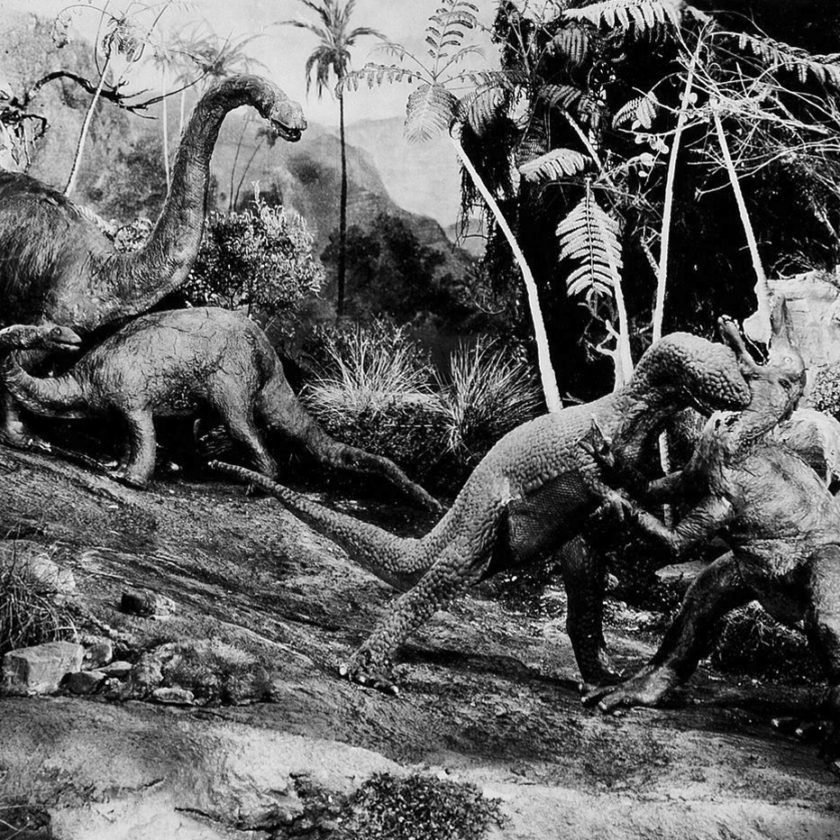
Mention British author
Sir Arthur Conan Doyle and immediately somebody would respond he wrote
the "Sherlock Holmes" stories.
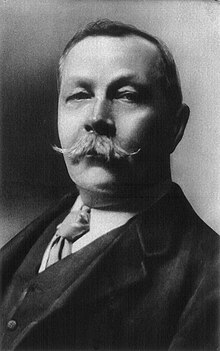
Above Conan Doyle in
1914.
The fact that he created "Sherlock Holmes" for the "The Strand Magazine" overshadows his many other works. Conan Doyle wrote a concise history of
the "Boer War", in which he had been a war correspondent, and other fiction, like "The Adventures of Brigadier Gerard", "The Stark Munro Letters", which is semi-autobiographical fiction and "The Great Keinplatz Experiment and Other Tales of Twilight and the Unseen".
Sir Arthur was also a believer in "Spiritualism" and his verbal and written battles with illusionist Erik Weisz, better known as Harry Houdini, made the international newspapers and in books the two wrote. I have an autographed copy of Conan Doyle's,
Sir Arthur was also a believer in "Spiritualism" and his verbal and written battles with illusionist Erik Weisz, better known as Harry Houdini, made the international newspapers and in books the two wrote. I have an autographed copy of Conan Doyle's,
It is another of Sir
Arthur Conan Doyle's characters that we are concerned with for this article.
Published first in serialized form, between April and November 1912 in the
United Kingdom's "The Strand Magazine" and in the United States
in "Collier's Magazine", was his science fiction
adventure "The Lost World". Later that same year the
first hardcover edition was released in the U.K.

"The Lost
World" introduced Zoologist
"Professor George Edward Challenger". There would be two more novels
featuring the Professor. In 1913 Doctor Sir Arthur Conan Doyle used his medical
knowledge and had "Challenger" deal with "The Poison
Belt". As the Earth passes through a belt of poison gas
encircling it. There would be one more adventure for the "Professor"
and his three companions, "Reporter Edward Malone", "Professor
Summerlee" and "Explorer Lord John Roxton". However, "The
Land of Mist" wouldn't be published until 1926 and dealt with
"Spiritualism".
Here is how
"Reporter Ed Malone" first described "Professor Challenger" in 1912's "The Lost World":
His appearance made me gasp. I was prepared for something strange, but not for so overpowering a personality as this. It was his size, which took one's breath away – his size and his imposing presence. His head was enormous, the largest I have ever seen upon a human being. I am sure that his top hat, had I ventured to don it, would have slipped over me entirely and rested on my shoulders. He had the face and beard, which I associate with an Assyrian bull; the former florid, the latter so black as almost to have a suspicion of blue, spade-shaped and rippling down over his chest. The hair was peculiar, plastered down in front in a long, curving wisp over his massive forehead. The eyes were blue-grey under great black tufts, very clear, very critical, and very masterful. A huge spread of shoulders and a chest like a barrel were the other parts of him which appeared above the table, save for two enormous hands covered with long black hair. This and a bellowing, roaring, rumbling voice made up my first impression of the notorious Professor Challenger.
Below is how illustrator
Harry Roundtree, who did the first two novels, envision the Professor seated in
a chair in 1913's "The Poison Belt".
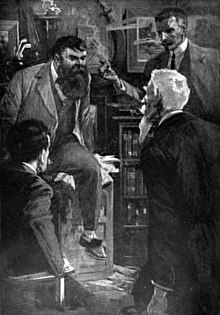
FIRST STEPS
The following are the words of Stop Motion Animator Ray Harryhausen from pages 56 and 57 of his "A Century of Stop Motion Animation", co-written with Tony Dalton, about his mentor Willis Harold "Obie" O'Brien:
The following are the words of Stop Motion Animator Ray Harryhausen from pages 56 and 57 of his "A Century of Stop Motion Animation", co-written with Tony Dalton, about his mentor Willis Harold "Obie" O'Brien:
Obie moved to the East Coast in 1915. William O'Brien accompanied his son to the train station and Darlene (Obie's first wife) recollected that, "As Obie and his father stood at the station, his father took off his heavy overcoat and handed it to Obie". At the New York Studios (The Thomas Edison Studio) he was allocated a small working area, which the other employees nicknamed "Manikin Productions". As with The Dinosaur and the Missing Link and Birth of a Flivver, he wrote the stories, built the models, constructed and painted the sets and then directed and photographed each film. The first was R.F.D. 10,000 B.C. (1916) about a prehistoric mailman called Henry Saurus (a typical Obie joke), whose post cart is pulled by a brontosaurus and who is vying with Johnny Bearskin for the affections of Winnie Warclub on Valentine's Day.
Two years later Willis
O'Brien was out of work. Continuing with Ray:
His chance came in 1918 when another model animator and sculptor, Major Herbert M. Dawley, who had been impressed with Obie's films for Edison, contacted him to ask if he would like to participate in a possible project. Dawley's experimentation in animation had been much cruder than Obie's but Obie thought that at least he would be working someone who had an idea of what animation was all about. Dawley gave him a three-month contract and so Obie returned to New York to work in Dawley's New Jersey studio in Chatham. The project that materialized there was based on an idea Obie had had for some time, which they called The Ghost of Slumber Mountain (Released November 17, 1918).

Most of the plot of this
19 minute short is unknown, We do know that author and explorer "Jack
Holmes", played by Herbert Dawley, tells his two young nephews a
story about the ghost of "Mad Dick", played by
Willis O'Brien, and there are dinosaurs involved,
THE LOST WORLD premiered February 2, 1925


Before that premiere
date, a feature film had to be made and that started six years earlier in 1919.
When Willis O'Brien went to work for Watterson R. Rothacker. Who was the West
Coast manager of "Billboard Magazine" and founder of
the "Industrial Motion Picture Company".
According to Ray
Harryhausen, page 60:
Ever since its publication in 1912. Obie had been obsessed with an adventure novel written by Sir Arthur Conan Doyle called The Lost World.
Initially, O'Brien was
contracted to film a series of shorts, but he also knew that Rothacker held the
United States rights to all of Conan Doyle's works. So, he started to work on
him with the idea of turning the novel into a feature film with animated
dinosaurs. With sketches of proposed scenes, Willis O'Brien met with Watteson R.
Rothacker and found an enthusiastic employer.
Rothacker
approached "Associated First National Pictures, Inc". That
along with its counterpart, "Associated First National Theatres,
Inc." had just been created from 1917's "First
National Exhibitor's Circuit" to provide additional funding for
the project. Both of those spin-off companies came back
together in 1924, one year prior to the release of Willis O'Brien's
dream feature film, reorganized as "First National
Pictures". A company that would be acquired by the small
Hollywood Boulevard studio owned by Harry, Albert, Sam and Jack Warner.in 1928, because of "First National Pictures" location in an unincorporated area
of Los Angeles called Burbank,
The story of "First
National Pictures" is part of the "Myth of Hollywood". I break
that myth in my article:
"HOLLYWOOD:
Segregated Housing, Motion Picture Studios and Movie Palaces" found at:
Also in 1919, Willis
O'Brien started attending sculpture classes at the "Otis Art
Institute (now known as the "Otis College of Art and
Design"), located at 9045 Lincoln Boulevard in Los Angeles. In
1921, Obie met a Mexican student studying sculpture at the Institute named
Marcel Delgado. Whom he asked to work with him on the feature.
Delgado didn't want to leave his job at as local grocery store, but after being talked into visiting the movie studio. The young sculptor decided to work with O'Brien and a twenty-five-year teaming began.
Delgado didn't want to leave his job at as local grocery store, but after being talked into visiting the movie studio. The young sculptor decided to work with O'Brien and a twenty-five-year teaming began.
For those who have
overlooked, or do not know who built Willis O'Brien's dinosaurs. My
article "MARCEL DELGADO: The Artist That Built 'King
Kong" may be read at:
According to Neil
Pettigrew for his 1999 "The Stop-Motion Filmography", page
427.
Sir Arthur Conan Doyle
showed some of Willis O'Brien's test footage to a 1922 meeting of the "Society
of American Magicians" with Harry Houdini in the audience. Some
of the footage showed a Triceratops Family and an Allosaurus attacking.
According to Pettigrew, the New York Times ran a front page article starting the
Conan Doyle's:
monsters of the ancient world, or of the new world which he has discovered in the ether, were extraordinarily lifelike. If fakes, they were masterpieces.

Willis O'Brien based his dinosaurs upon American Paleoartist Charles R. Knight.
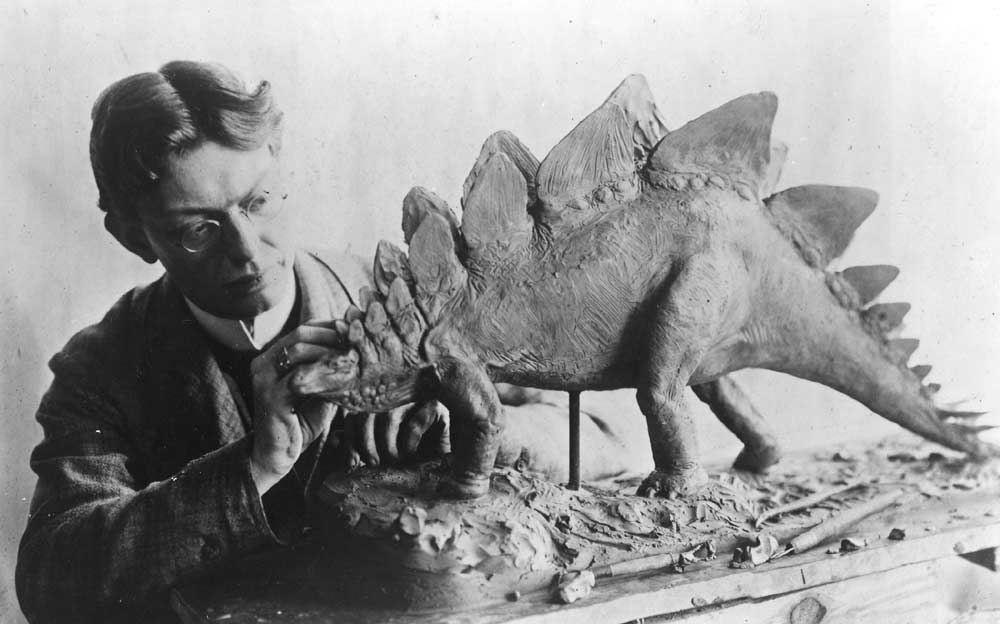
Above Knight in 1899 working on a model of a Stegosaurus. Below Willis O'Brien's Stegosaurus in 1925's "The Lost World".

Below are two illustrations of dinosaurs by Charles R. Knight.


Although, the motion
picture was brought to "First National Pictures" by Watterson R,
Rothacker. Who, according to Ray Harryhausen, provided the initial funding, he
is not listed on the official "Full Cast and Crew Listing" as a
producer of the film. His name is listed 9th under the heading "Other
Crew", but more importantly on the pictures title card saying:
By arrangement with Watterson R. Rothacker
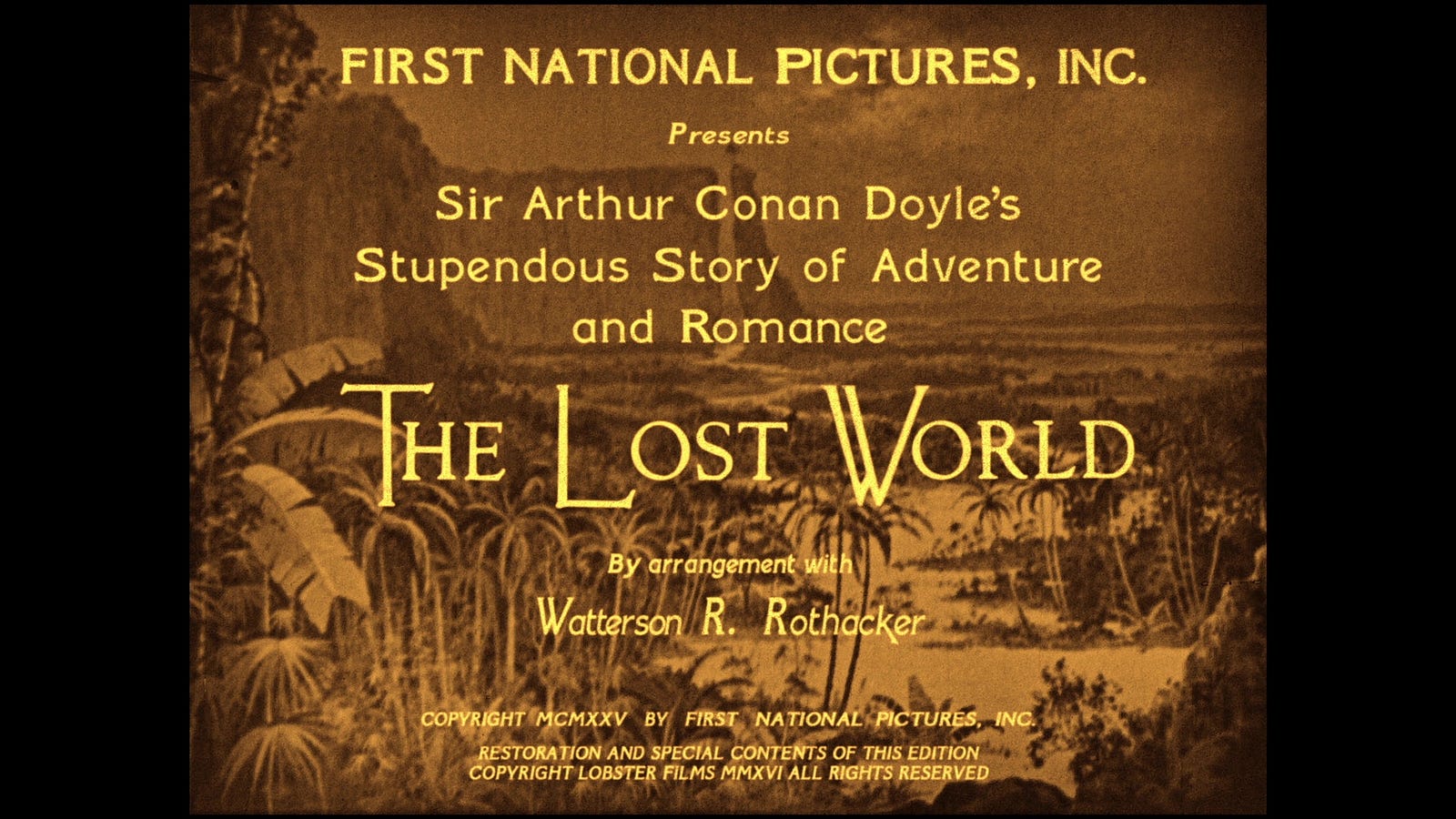
The 1925 feature film's
producer was Earl Hudson, but his name will not be seen on the motion picture
screen. As a producer Hudson only has 8 film credits between 1924 and 1926 and
this was his second. Between 1924 to 1928 he adapted 8 novels for the silent
screen, but his main credits come under the heading of "Miscellaneous
Crew". Between 1924 and 1927 Hudson is listed as "Supervisor" of
21 feature films including "The Lost World". Which
meant that he oversaw the entire production for "First National
Pictures".
What is interesting is
that Harry O. Hoyt is the listed director, but the distinction on the
"Full Cast and Crew Listing" states that was only for "Dramatic
Direction". Which means Hoyt's involvement was to direct the
actors only. We know that Willis O'Brien would have been involved with
directing them in the scenes with the stop motion dinosaurs.

Above Harry O. Hoyt

Above Harry O. Hoyt
Between 1915 and 1951
Harry Hoyt directed 28 features of which 6 are short subjects. While between
1913 and 1948 he was involved with writing the screenplays for 81 "B"
features, or shorts but not this picture.
Willis O'Brien's name is
found listed on the "Full Cast and Crew Listing" twice. First under the
heading "Other Crew" as a "Researcher and
Technical Director" and, without credit, under "Special
Effects By".


While Marcel Delgado, below, is listed three time. The first under "Other Crew" as "Associate
Researcher", the second under "Visual Effects" as "Associate
Technical Director", and the third under "Special Effects
By" without credit,
Look on the "Full Cast and Crew Listing" and you will find a
entry under "Visual Effects" reading "Minatures". Next
to it is the name of British model maker Cleo E. Baker, aka: Charles Baker. He received no official credit for his work on the picture. Below, Baker sits on a
table as one his crew works on a model for the final sequences in "The
Lost World".

The screenplay has two
names listed. The first is Sir Arthur Conan Doyle and next to his name is
"Based Upon the 1912 Novel". The second is Marian Fairfax
for the screenplay. She was a known Broadway playwright and between 1915 and
1926 she worked on 26 screenplays. Between 1924 and 1925 Fairfax was the
editorial director, actually the "go-between", between the studio and the press for 11 feature films
including this production.
Miss Bessie Love
portrayed "Paul White". Her career between 1915 and
1983 totaled 156 different roles. You will find Love listed 27th in director
D.W. Griffith's 1916 "Intolerance: Love's Struggle Through the
Ages" and she had several starring roles in silent and early
talkie films. Later in her career, Bessie Love moved to England and appeared in
small roles in British films. She's a plane passenger in the James
Stewart, Marlene Dietrich and Glynis Johns 1951 "No Highway in the
Sky", Love's a grandmother in the science fiction sequel, of sorts, to 1960's "Village of the Damned", 1964's "Children
of the Damned" and she portrayed a "Matron" in
the 1967 science fiction "Battle Beneath the Earth". In
1969 Besse Love sat at the Baccarat table opposite George Lazenby's "James
Bond" in "On Her Majesty's Secret Service".


Mr. Lewis Stone portrayed "Sir
John Roxton" and not Conan Doyle's name of "Lord John Roxton". Stone's acting career spans 1915 through 1953 and he
starred in the 1922 silent "The Prisoner of Zenda", and
co-starred in the 1923 version of Rafael Sabatini's "Scaramouche". When
sound came, in 1932, Lewis Stone portrayed "Nayland
Smith". Who is after Boris Karloff's "Fu Manchu", but Stone would became known for portraying "Judge Hardy" in the
Mickey Rooney "Andy Hardy" film series.

Mr. Wallace Beery
portrayed "Professor Challenger". Beery was a
character actor and leading man from the silents into sound. In 1920 he
portrayed "Magua" in the 1920 "The Last
of the Mohicans", was "Pat Garrett" in
the 1930 "Billy the Kid" and co-starred with Jackie
Cooper in 1931's "The Champ". During 1934 Wallace
Beery was "Long John Silver" with Jackie
Cooper's "Jim Hawkins" in "Treasure
Island", played "P.T. Barum" in
the "The Mighty Barum" and "Pancho
Villa" with Fay Wray in "Viva Villa".

Mr. Lloyd Hughes
portrayed "Ed Malone". Hughes was a silent screen
leading man and at times portrayed the villain later in his career. Some of his
pictures included co-starring with Lionel Barrymore in the part silent-part
sound 1929 Jules Verne's story "The Mysterious Island". Hughes
co-starred with Lionel's brother, John Barrymore, in 1930's "Moby
Dick", in 1937 Lloyd Hughes played the evil "Scorpion" in
the 15 Chapter Serial "Blake of Scotland Yard".


Above Lloyd Hughes and
Bessie Love
Miss Alma Bennett
portrayed "Gladys Hungerford". Between 1919 and 1931
Bennett was seen in 64 films. She was known for portraying "1920's "Vamps"
aka: "Femme Fatales" and appearing in silent westerns,
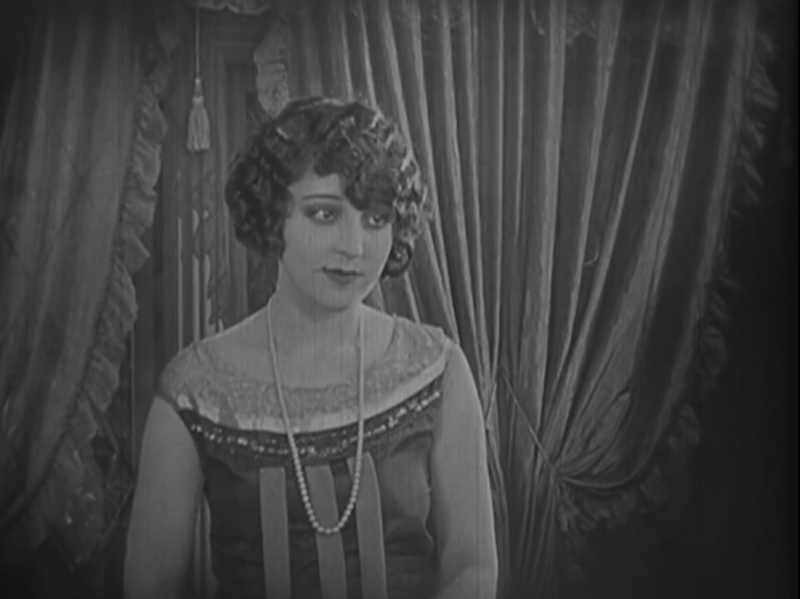
Mr. Arthur Hoyt
portrayed "Professor Summerlee". Yes, he was
director Harry O. Hoyt's brother, but Arthur had been on the Broadway stage
since 1905 and had appeared in 49 feature films by "The Lost
World". Character actor Arthur Hoyt's last film was comedian
Harold Lloyd's 1947 "The Sins of Harold Diddlebock" and
his 288th role.
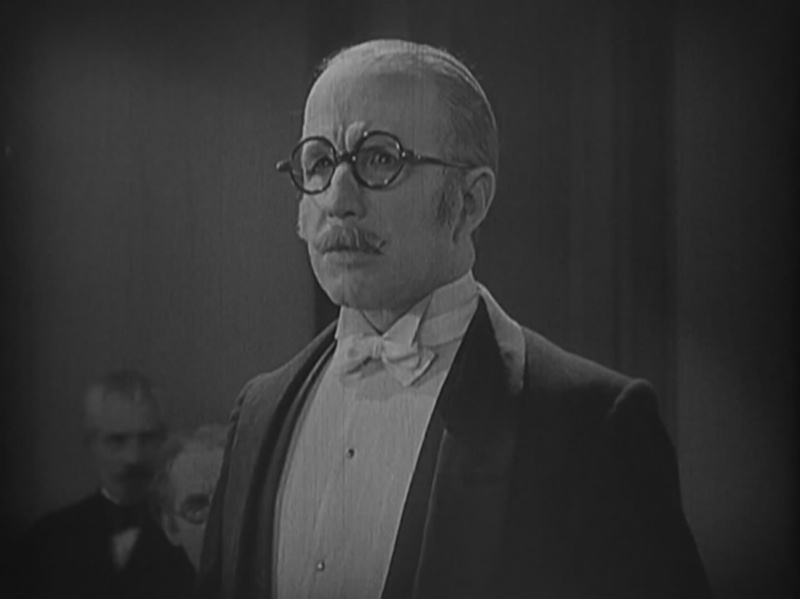
Miss Margaret McWade
portrayed "Mrs. Challenger". Vaudeville actress
McWade started acting in films in 1914 and mainly portrayed wives and later
spinsters. She played "Calvus' wife" in Merian C.
Cooper's 1935 "The Last Days of Pompeii", "Amy
Faulkner" in Frank Capra's 1936 "Mr. Deeds Goes to
Town", and the "Younger Sister" in
1939's "The Hunchback of Notre Dame".
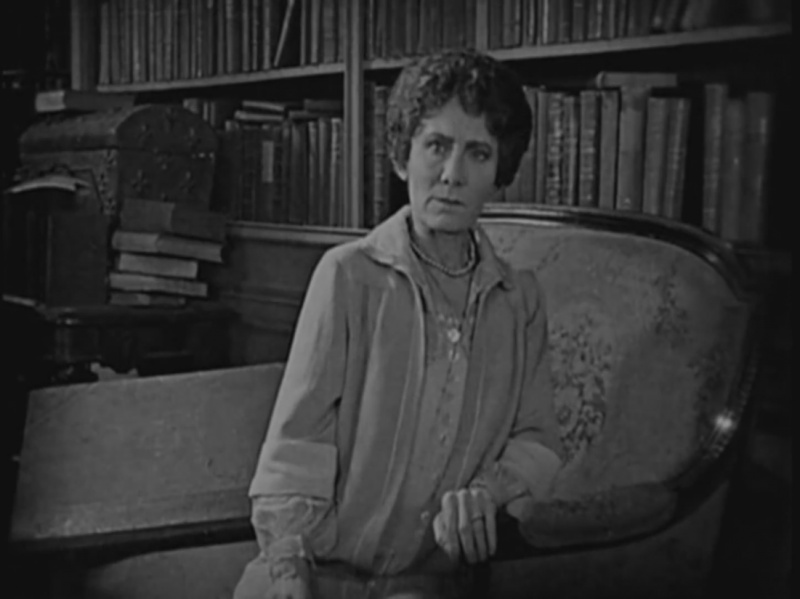
Mr. Bull Montana portrayed the "Ape-man". Luigi
Montagna aka: Bull Montana was a professional wrestler managed by actor Douglas
Fairbanks for several decades. His acting career started in 1917 and ended in
1937 after 90 roles. Again, we have another person not receiving proper credit
for his work. Bull Montana's make-up design and application was by Cecil
Holland. Holland also did the make-ups for the Boris Karloff, 1932 "The
Mask of Fu Manchu" and the same year's Lionel, Ethel and John
Barrymore's "Rasputin and the Empress". Both motion pictures without
proper credit, but once again, a sign of the times.

Mr. Finch Smiles portrayed "Austin". His name was actual Frank Finch Smiles and between 1924 and 1929 was only in 19 motion pictures. None of them major films from both sides of the Atlantic.
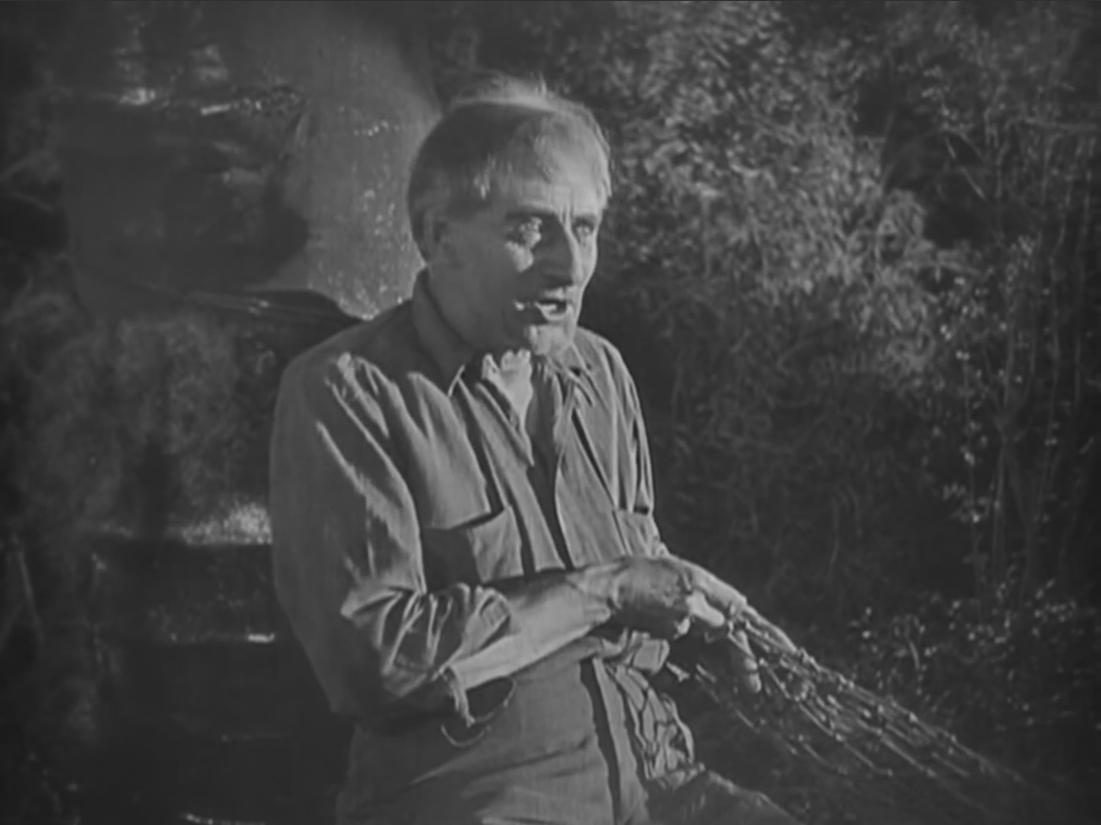
Mr. Jules Cowles portrayed "Zambo" in full blackface. Between 1914 and 1943 the actor appeared in 136 different roles. Of which 74 were so small he received no on-screen credit for his acting. Also, on the official "Cast and Crew Listing" the character of "Zambo" is listed as Indian from India.
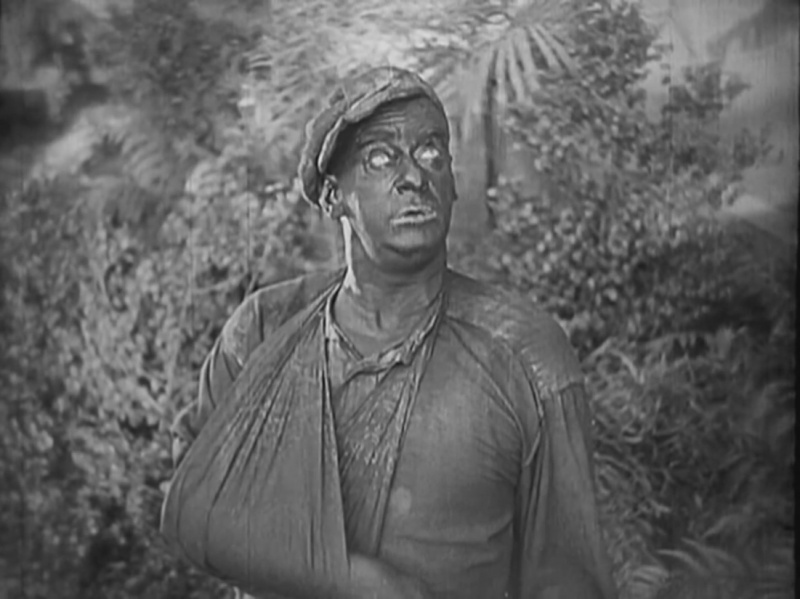
Mr. George Bunny portrayed "Colin McArdle". Between 1915 and 1951 Bunny appeared in 66 motion pictures. Most of them being either "B" westerns and adventure features.
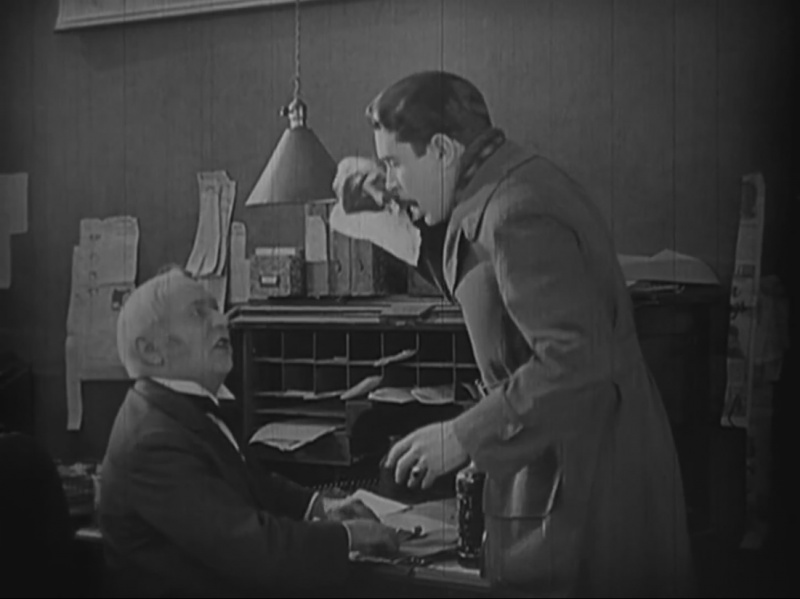
Above left George Bunny as newspaper editor "McArdle" is speaking to Lloyd Hughes as his reporter "Ed Malone".
Mr. Charles Wellsley portrayed "Major Hibbard". Irish actor Wellsley would appear on-screen 93 times between 1911 and 1928. Along with "The Lost World", Charles Wellsley was in Lon Chaney's 1925 "The Unholy Three".
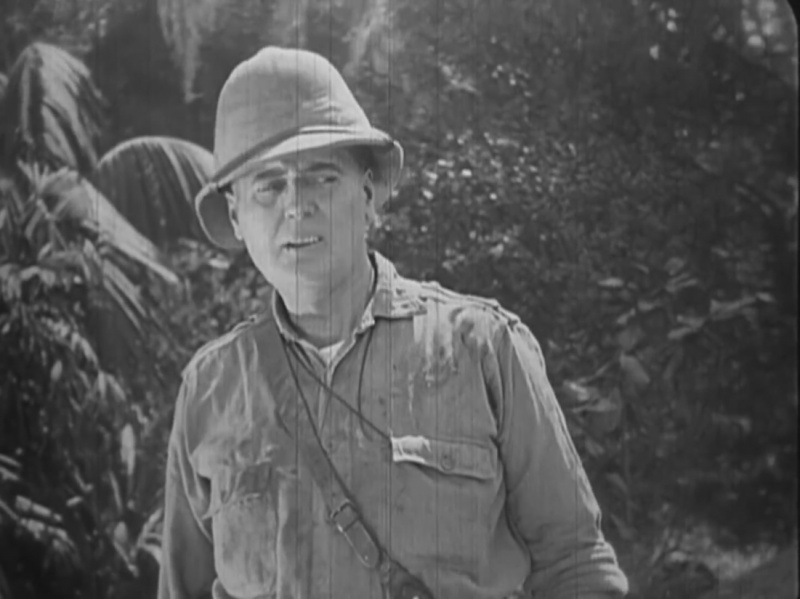
Jocko portrayed "Jocko".


Mr. Finch Smiles portrayed "Austin". His name was actual Frank Finch Smiles and between 1924 and 1929 was only in 19 motion pictures. None of them major films from both sides of the Atlantic.

Mr. Jules Cowles portrayed "Zambo" in full blackface. Between 1914 and 1943 the actor appeared in 136 different roles. Of which 74 were so small he received no on-screen credit for his acting. Also, on the official "Cast and Crew Listing" the character of "Zambo" is listed as Indian from India.

Mr. George Bunny portrayed "Colin McArdle". Between 1915 and 1951 Bunny appeared in 66 motion pictures. Most of them being either "B" westerns and adventure features.

Above left George Bunny as newspaper editor "McArdle" is speaking to Lloyd Hughes as his reporter "Ed Malone".
Mr. Charles Wellsley portrayed "Major Hibbard". Irish actor Wellsley would appear on-screen 93 times between 1911 and 1928. Along with "The Lost World", Charles Wellsley was in Lon Chaney's 1925 "The Unholy Three".

Jocko portrayed "Jocko".

The Basic Screenplay:
From a lost expedition to a plateau in Venezuela, "Paula White", the daughter of the expeditions leader, "Maple White", brings his journal to the eccentric explorer "Professor George Edward Challenger" in London, England.
The journal contains sketches of live dinosaurs, drawn by Willis O'Brien, and enough information to convince "Professor Challenger" that Prehistoric animals till live. He goes to the "London Zoological Society" to make this claim, but is ridiculed by the others including "Professor Summerlee". "Challenger's" speech intrigues reporter "Ed Malone" and he volunteers for the expedition, but the Professor hates reporters and "Malone" is chased out of the building.
Later, "Malone" breaks into the Professor's house and confronts him and his wife. The Professor again tries to beat him up and a police officer, standing on a street, as the two men come rolling out of the house, wants to arrest "Challenger" for attacking "Malone", but the reporter says he won't press charges, Next, "Malone" mentions he's a friend of "Sir John Roxton" and "Professor Challenger" asks why he didn't say that before?
"Challenger" introduces the reporter to "Paul White" as "Sir Roxton" arrives and suggests the Professor show "Malone" the journal.
After reading some of the journal "Malone" suggests, if he can go on the expedition to cover it. He could get his newspaper to fund the expedition as a rescue mission for "Maple White". An agreement is reached between the two men and now all the reporter needs to do is get his paper to also agree and "Roxton" accompanies him.
"Ed Malone's" interest is really to impress his girlfriend "Gladys Hungerford". Who doesn't want a stay at home newspaper man, but a "Man of Great Deeds!" This plot line comes directly from Conan Doyle's novel. "Malone" and "Roxton" goes to the newspaper's owner and about the expedition.

The expedition is formed.

Above are four members of the expedition, "Professor Challenger", "Paula White", "Sir John Roxton" and "Ed Malone" with "Mrs. Challenger". Also on the expedition is a very skeptical "Professor Summerlee", "Challenger's servant Zambo" and his butler "Austin".
Arriving at the base of the plateau a campsite is set up with the plan of having "Austin" and "Zambo" remain there. The river the audience sees in the motion picture was actually a sewer on the Metro-Goldwyn-Mayer Culver City studio lot.

Looking up at the plateau "Challenger" spots a Pteranodon that attacks a Toxodon. It should be noted that whomever wrote the original title cards mistakenly called the Pteranodon a Pterodactylus, but this was corrected for the 2001 release.

A large boulder falls from the top of the plateau and the members of the expedition are surprised that it was pushed over by an "Ape-man".
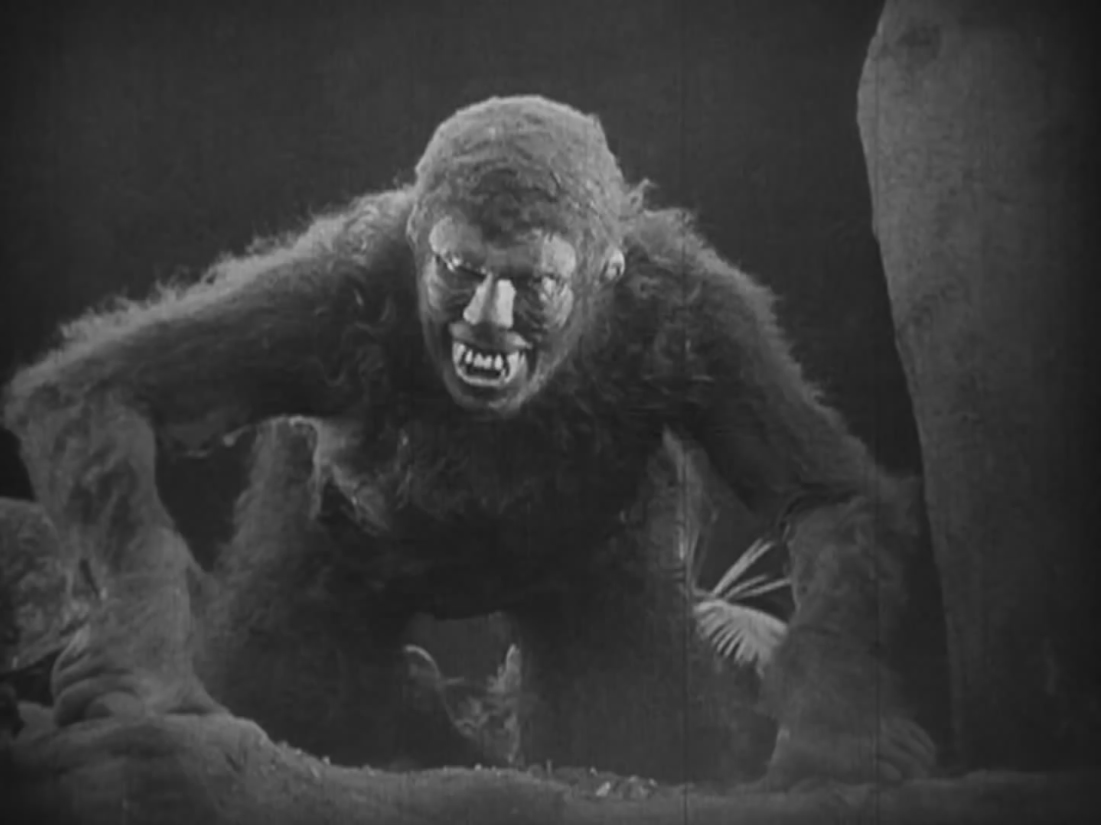
From a lost expedition to a plateau in Venezuela, "Paula White", the daughter of the expeditions leader, "Maple White", brings his journal to the eccentric explorer "Professor George Edward Challenger" in London, England.
The journal contains sketches of live dinosaurs, drawn by Willis O'Brien, and enough information to convince "Professor Challenger" that Prehistoric animals till live. He goes to the "London Zoological Society" to make this claim, but is ridiculed by the others including "Professor Summerlee". "Challenger's" speech intrigues reporter "Ed Malone" and he volunteers for the expedition, but the Professor hates reporters and "Malone" is chased out of the building.
Later, "Malone" breaks into the Professor's house and confronts him and his wife. The Professor again tries to beat him up and a police officer, standing on a street, as the two men come rolling out of the house, wants to arrest "Challenger" for attacking "Malone", but the reporter says he won't press charges, Next, "Malone" mentions he's a friend of "Sir John Roxton" and "Professor Challenger" asks why he didn't say that before?
"Challenger" introduces the reporter to "Paul White" as "Sir Roxton" arrives and suggests the Professor show "Malone" the journal.
After reading some of the journal "Malone" suggests, if he can go on the expedition to cover it. He could get his newspaper to fund the expedition as a rescue mission for "Maple White". An agreement is reached between the two men and now all the reporter needs to do is get his paper to also agree and "Roxton" accompanies him.
"Ed Malone's" interest is really to impress his girlfriend "Gladys Hungerford". Who doesn't want a stay at home newspaper man, but a "Man of Great Deeds!" This plot line comes directly from Conan Doyle's novel. "Malone" and "Roxton" goes to the newspaper's owner and about the expedition.

The expedition is formed.

Above are four members of the expedition, "Professor Challenger", "Paula White", "Sir John Roxton" and "Ed Malone" with "Mrs. Challenger". Also on the expedition is a very skeptical "Professor Summerlee", "Challenger's servant Zambo" and his butler "Austin".
Arriving at the base of the plateau a campsite is set up with the plan of having "Austin" and "Zambo" remain there. The river the audience sees in the motion picture was actually a sewer on the Metro-Goldwyn-Mayer Culver City studio lot.

Looking up at the plateau "Challenger" spots a Pteranodon that attacks a Toxodon. It should be noted that whomever wrote the original title cards mistakenly called the Pteranodon a Pterodactylus, but this was corrected for the 2001 release.

A large boulder falls from the top of the plateau and the members of the expedition are surprised that it was pushed over by an "Ape-man".

The group climbs the easier right side of the chasm, chops down a tree and uses it to cross to the larger side. Then a Brontosaurus comes by and knocks the tree off trapping them.

The members of the rescue party establish their own campsite and
start to explore the plateau. They become amazed of what they witness while searching for both
"White" and a way off.

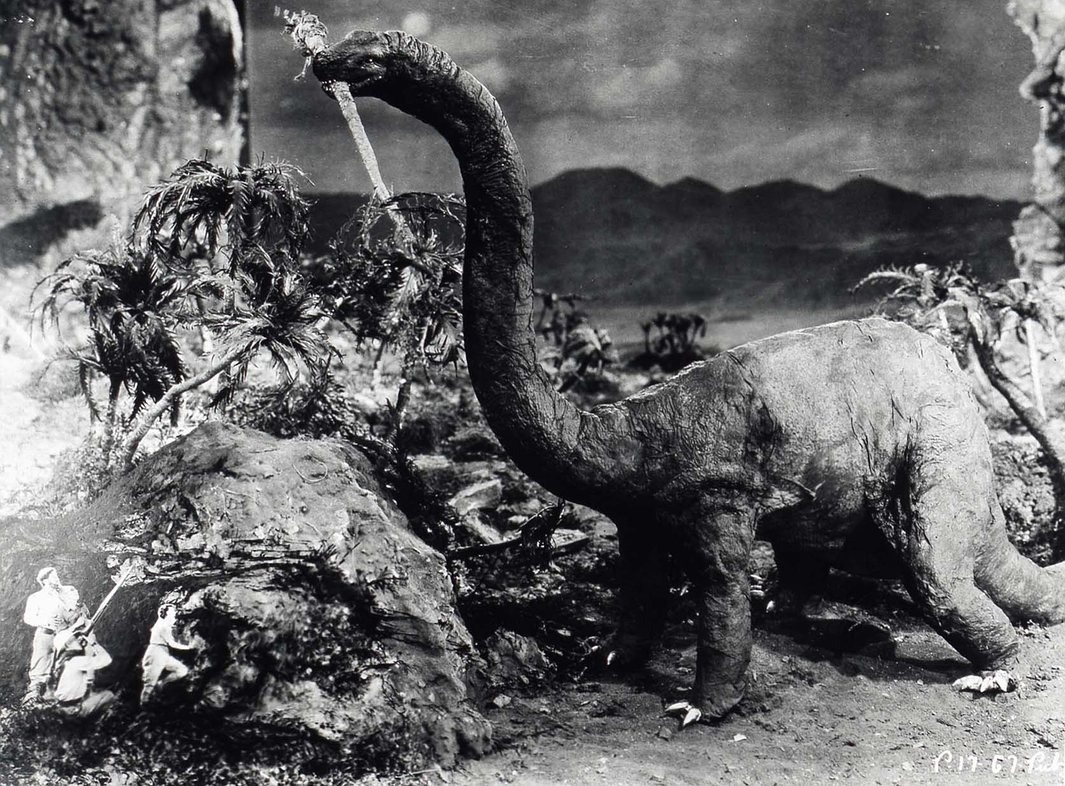
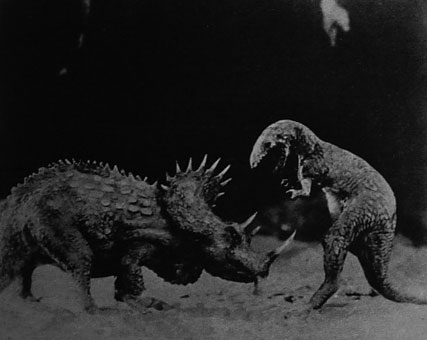
Returning to their campsite an Allosaurus attacks.
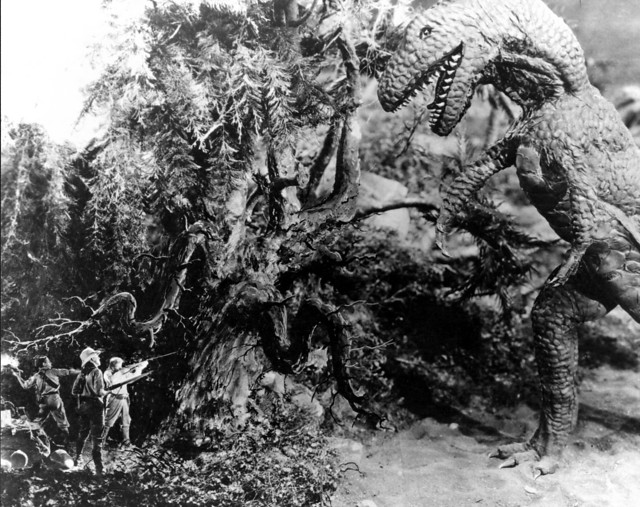
"Malone" throws a torch into the mouth of the Allosaurus that causes it to leave.
"Ed Malone" now climbs a tree to get a better idea of the group's location and is attacked by the "Ape-Man". "Roxton" shoots the "Ape-Man" that then leaves to nurse his wounds. The explorers move into a cave "Malone" had spotted.



Returning to their campsite an Allosaurus attacks.

"Malone" throws a torch into the mouth of the Allosaurus that causes it to leave.
"Ed Malone" now climbs a tree to get a better idea of the group's location and is attacked by the "Ape-Man". "Roxton" shoots the "Ape-Man" that then leaves to nurse his wounds. The explorers move into a cave "Malone" had spotted.

Below an Agathaumas attacks and
kills a Brontosaurus.


Then the same Agathaumas is
attacked and killed by an Allosaurus. Below a Tryranosaurus Rex roams the
plateau in search of a kill. Compare it to the Knight painting.
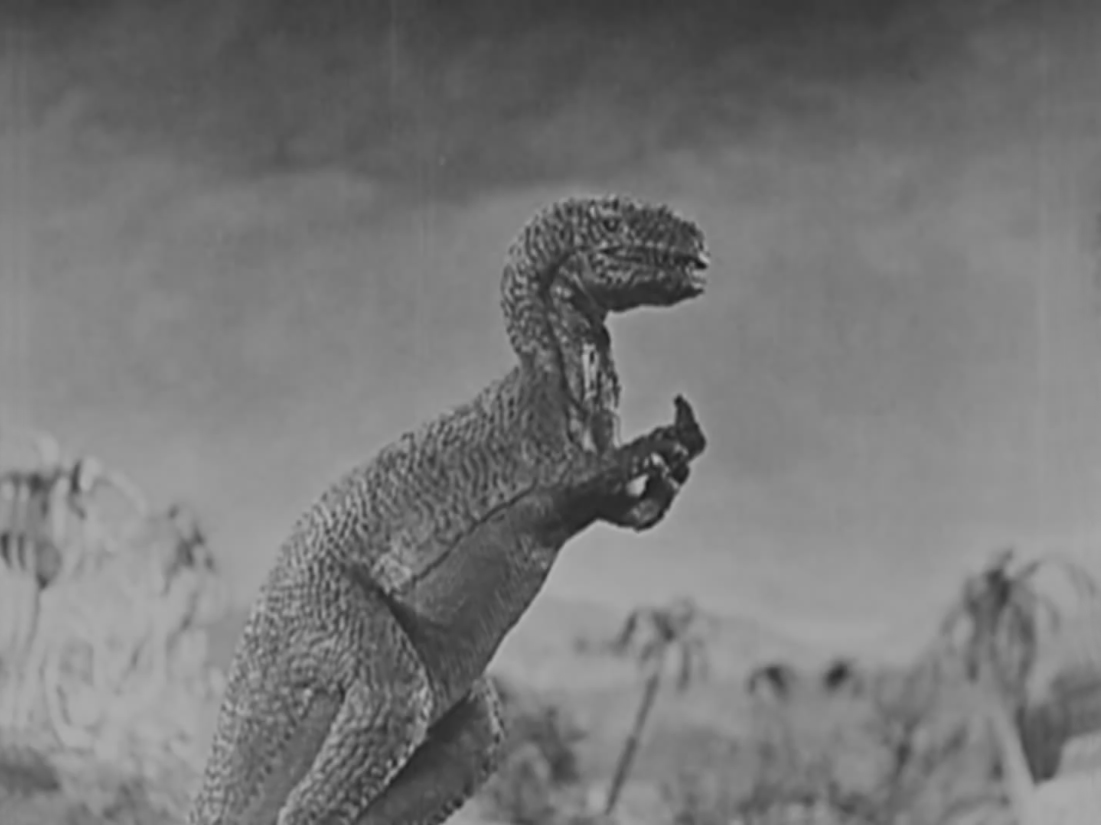

Above two dinosaurs are fighting
near the edge of the plateau. The Brontosaurus falls off into the mud far
below, becoming trapped. On the jungle floor "Austin" and
"Zambo" have been constructing a rope ladder big enough to reach the
top of the plateau and have an idea how to get it there.

While searching for "Maple
White", "Sir John Roxton", discovers "Paula's" fathers
remains within another section of the cave they've been using as their base. He confirms "White's" death by finding a watch with "Paul's" picture in it. Then from the cave, looking down a cliff, "Roxton" see's the base camp and makes contact with "Austin" and
"Zambo".

_NRFPT_01.jpg)

_NRFPT_01.jpg)
Whilw that is transpiring "Ed Malone" admits his love for "Paula White", but she
doesn't want to hurt "Gladys" by taking her boyfriend. It is obvious
from the film's start that "Sir John Roxton" also loves
"Paula".
Below in the jungle "Major Hibbard" and some others see the plateau's
volcano starting to erupt.
On the plateau the volcano does erupt and the dinosaurs panic. Meanwhile, "Austin" and "Zambo" use "Paula's" pet monkey "Jocko" to climb up with a small rope tied to the ladder. The monkey reaches the others and the ladder is pulled up. On his way down "Ed Malone" is again attacked by the "Ape-Man" and it is shot once more by "Sir John Roxton" and killed.
On the plateau the volcano does erupt and the dinosaurs panic. Meanwhile, "Austin" and "Zambo" use "Paula's" pet monkey "Jocko" to climb up with a small rope tied to the ladder. The monkey reaches the others and the ladder is pulled up. On his way down "Ed Malone" is again attacked by the "Ape-Man" and it is shot once more by "Sir John Roxton" and killed.
At the base of the plateau the
Brontosaurus is found alive and "Major Hibbard" appears identifying
himself as a "Colonial Game Warden". He tells "Challenger" that once the rainy season starts the following month. How they can get the
dinosaur to the Amazon River and brought back to London.
The Brontosaurus is being transferred from a merchant ship to the dock and the cage falls to the dock. The dinosaur escapes and starts running loose in London. Eventually, while crossing London Bridge his weight causes it to give way and the Brontosaurus falls into the Thames River and
heads for home.

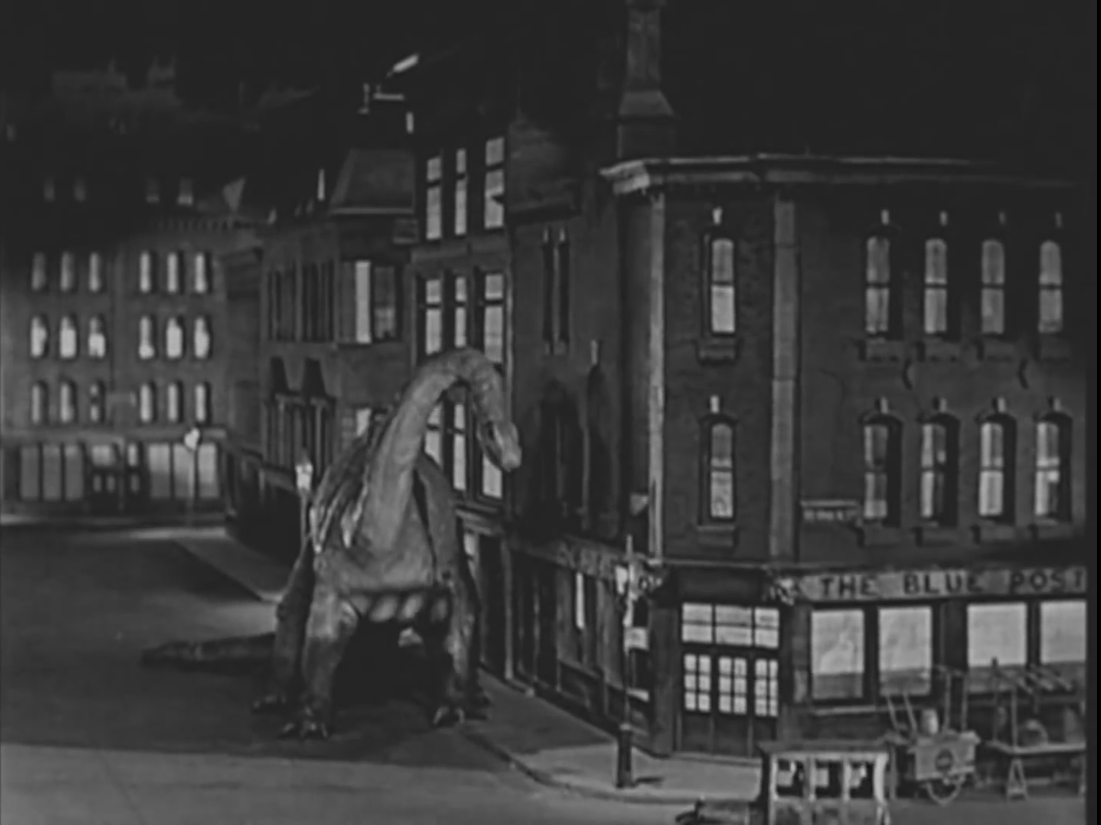
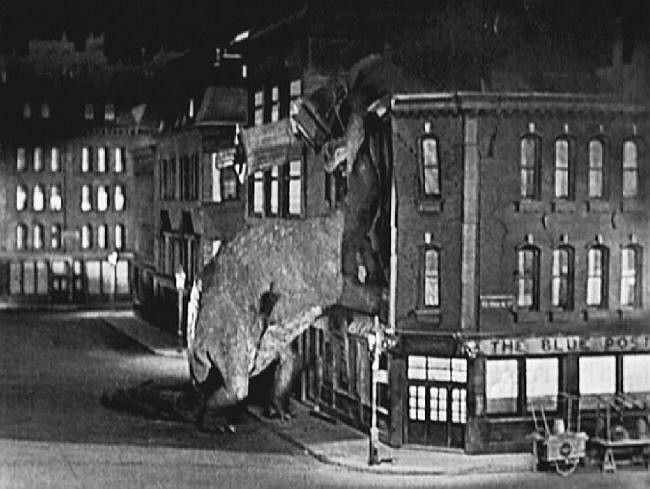
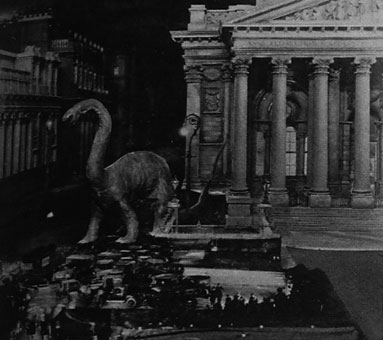

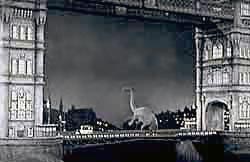
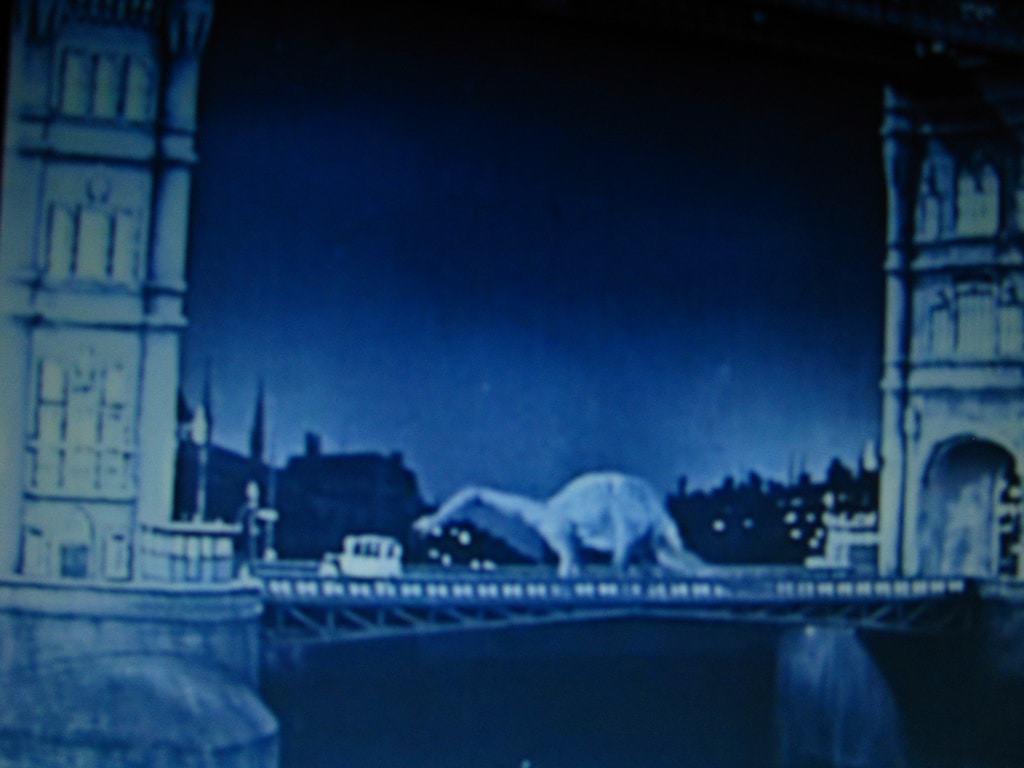

"Ed Malone" discovers that "Gladys Hungerford" has married while he was gone, The surprise is her husband's not a "Man of Great Deeds" like she wanted "Malone" to become, but, the fickled "Gladys", married a plain store salesman.
"Sir John Roxton" gallantly hides his love for "Paula" and wishes her and "Ed" well.
Closing Titles.
A Bit of Trivia:
1925's, "The Lost World", as part of a publicity stunt that caught on, became the first in-flight movie.
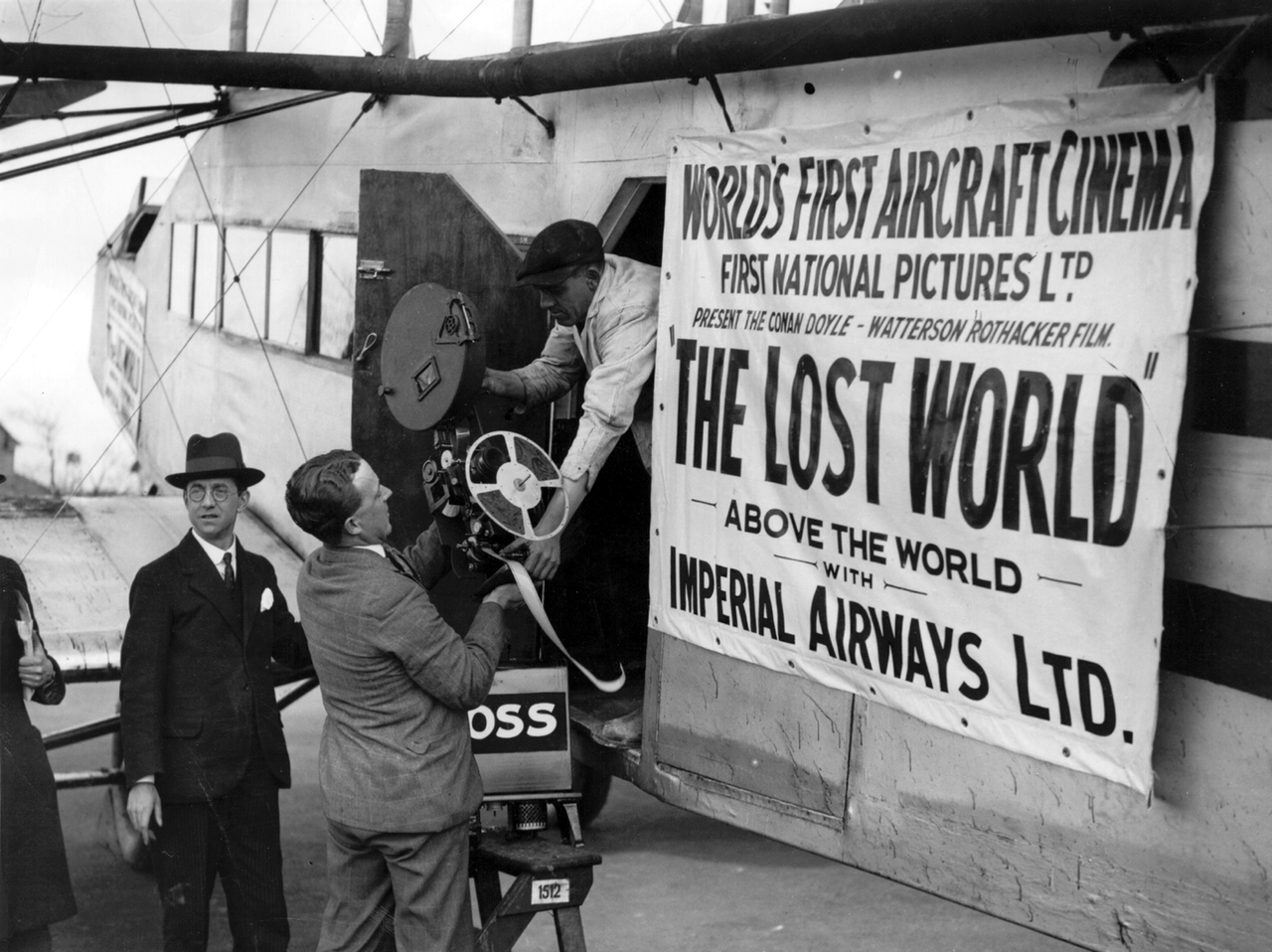
In 1960 producer Irwin Allen
released his version of the Sir Arthur Conan Doyle novel. He had approached
Willis O'Brien about working upon his version. Obie showed up, at their initial meeting, with
sketches he had made of the dinosaurs Obrien wanted to put in the picture through Stop Motion Animation.
Look at the "Full Cast and Crew" of Irwin Allen's "The Lost World" and you will find the name Willis O'Brien under the heading "Visual Effects by". He's listed fourth as an "Effects Technician".
Allen didn't want to spend the money for Stop Motion Animation. He just wanted O'Brien's name associated with the remake as a means of getting larger funding and publicity.


Above an Irwin Allen Brontosaurus. Below an Irwin Allen baby Tyrannosaurus Rex.

THE STORY OF GWANGI (Gwan-gee a Native American Word, per Willis O'Brien, for Lizard)
Look at the "Full Cast and Crew" of Irwin Allen's "The Lost World" and you will find the name Willis O'Brien under the heading "Visual Effects by". He's listed fourth as an "Effects Technician".
Allen didn't want to spend the money for Stop Motion Animation. He just wanted O'Brien's name associated with the remake as a means of getting larger funding and publicity.


Above an Irwin Allen Brontosaurus. Below an Irwin Allen baby Tyrannosaurus Rex.

THE STORY OF GWANGI (Gwan-gee a Native American Word, per Willis O'Brien, for Lizard)
The following paragraph tells of a meeting between Ray and Obie around the start of 1942. This was just before Ray Harryhausen found himself in Army Major and Motion Picture Director Frank Capra's "U.S. Army Signal Corps" photographic unit:
Just prior to going into the army, Obie invited me over to RKO for a chat and to see the work that was being done on Gwangi , as the project was than called. The dioramas, each about two feet across, were beautiful and had been constructed to illustrate where the rear-screen projector was to be and where the live action took place. Each dimensional cardboard set-up included cut-outs of the actors and creatures so you could see just how they would work.
Below is a photo, I took, of page 91 in "A Century of Stop Motion Animation". On the left is Willis O'Brien working on his "Gwangi" storyboards and on the right are three models of a Tyrannosaurus Rex made for the production by Marcel Delgado.

Another reflection, by Ray Harryhausen, on his mentor planning the never completed "Gwangi" project. Can also be found on page 91.
The years between 1939 and 1947 were perhaps the worst that Obie had experienced. In 1941 he began work at the Pathe Studios in Culver City on Gwangi, a story and a project of his devising, which was to have been produced by Joe Speaks back at his old stamping ground, RKO. It was a story close to his heart, involving an allosaurus, called Gwangi by Native Americans, which is discovered in a hidden valley by a group of cowboys. For Obie a story which included both horses, and his beloved dinosaurs was perfect. Aside from the allosaurus, the film was to have included a pterodactyl, a herd of tiny horses (ephippos) and a triceratops, all designed by Obie and built by Marcel Delgado.
According to Ray, the motion picture was to have been shot in Technicolor and
was a co-production of RKO Radio Pictures and Colonial Pictures. At the time,
RKO had already invested $50,000, equal to $872,595 in 2020, and a year of development.
When, right after Harryhausen entered the Army, the picture was just dropped.
There are many possible reasons for this action. One would have been the
overall cost, of a science fiction-fantasy-adventure feature, at a time that
the United States was suddenly switching to a wartime economy, or just the war
itself. Whatever was the real reason Willis O'Brien was never told. However, he
gave Ray a copy of the completed screenplay.
Then came 1949's "Mighty Joe Young". The use of cowboys in the motion picture and the roping of "Mr. Joseph Young", as the film credits called the O'Brien-Delgado-Harryhausen gorilla, was right out of "Obie's Original Gwangi Screenplay", but substituted the gorilla for the allosaurus.

Above is a clear shot of both the model "Joe Young" and a model "Cowboy". Below is a real actor and rear projection.

Below is the publicist release to the members of the "Academy of Motion Picture Arts and Sciences" pushing the film for "Oscar" consideration. Which it did win.

I want to call my reader's attention to two things on the above release. The first is the credit being given to:
The second is the line under:

It reads:
Then came 1949's "Mighty Joe Young". The use of cowboys in the motion picture and the roping of "Mr. Joseph Young", as the film credits called the O'Brien-Delgado-Harryhausen gorilla, was right out of "Obie's Original Gwangi Screenplay", but substituted the gorilla for the allosaurus.

Above is a clear shot of both the model "Joe Young" and a model "Cowboy". Below is a real actor and rear projection.

Below is the publicist release to the members of the "Academy of Motion Picture Arts and Sciences" pushing the film for "Oscar" consideration. Which it did win.

I want to call my reader's attention to two things on the above release. The first is the credit being given to:
Willis O'Brien of "The Lost World" and "King Kong" and Ray Harryhausen First Technician".
The second is the line under:
They made him alive!

It reads:
Now Preparing----"VALLEY OF THE MIST"---for Jessie L. Lasky Productions
Below is one of the drawings for
the production made by Ray Harryhausen.
The actual story was written by
Willis O'Brien and his wife Darlyne Prenett O'Brien in 1948. It was entitled "Emilio
and Guloso" with the alternate title of "The Valley of
the Mist". In it a young Mexican Boy, "Emilio",
and his pet bull, "Guloso", save their village from a dinosaur. In
1950 the project was dropped by Jesse L. Lasky, Sr., because of lack of
funding.
Five years later "Emilio
and Guloso" was resurrected and its alternate title would become
confused with Obie's original "Gwangi" concept.
THE BEAST OF HOLLOW
MOUNTAIN released in August 1956


Below the Spanish title "la BESTIA de la MONTANA" that translates as "The Mountain Beast".

Below the Italian poster for LA VALLE DEI DISPERATI" that translates as "The Valley of the Desperate".

Edward and William Nassour were two
Syrian-American brothers born in Colorado Springs, Colorado. They became
television and motion picture producers. Although the brothers would only
produce a total of six productions between 1951 and 1959. Besides "The
Beast of Hollow Mountain", two of these other productions were the popular television series "Sheena, Queen
of the Jungle" and the 1951 science fiction feature "The
Lost Continent" starring Cesar Romero.
Edward supervised the visual
effects teams on all of the brothers productions. He specially worked upon the
dinosaur sequences for "The Lost Continent" and the
added American volcano and dinosaur sequences for 1959's "Gigantis
the Fire Monster". The latter is the re-edited and
dubbed version of the 1955 Japanese film "Counterattack of
Godzilla" aka: "Godzilla Raids Again".
The Nassour Brothers purchased the screenplay "Emilio and Guloso" from Willis O'Brien. Which, also, brought them the somewhat confusing alternative title of the 1950 film attempt, "The Valley of the Mist".
Obie was next asked to expand his original story line and he lifted the same cowboy idea, as with "Mighty Joe Young", from his "Gwangi" concept. Seemingly tying "Emilio" and "Gwangi" together.
The main cowboys would now become an American Cattle Rancher living in Mexico near a Mexican town and a major Mexican Cattle Rancher wanting the other out of Mexico and ownership of that ranch. "Emilio" became a small boy, now named "Panchito" without a bull, living with his drunken father and initially working on a third ranch owned by a beautiful young women.
While the Allosaurus, became a legendary creature living not in a "Valley", but within the "Hollow Mountain". Which overlooked all three ranches and was surrounded by swamp land. The dinosaur is killing the cattle of both the American and large Mexican ranch owner. This is causing the two to charge each other was theft. Also the women ranch owner will become the love interest for the American. Making the Mexican rancher jealous, because she's suppose to marry him.
"The Beast of Hollow Mountain" was the first motion picture to use Willis
O'Brien's name mainly to attract funding and viewership. Rather than to have
Obie actually work upon the Stop Motion animation that was very low quality.
Robert Hill wrote the screenplay. Between 1952 and 1967 Hill only worked on a
total of 17 productions and the movies were very low "B" pictures.
However, his final two jobs were the television series "The Man
from U.N.C.L.E." and the "The Girl from
U.N.C.L.E.".
While additional dialogue was written by Jack DeWitt. Between 1941 and 1976 DeWitt either wrote the screenplays, or added additional dialogue and proof read 42 productions. Among these were Randolph Scott's 1949 "Canadian Pacific", 1959's had hitting and truthful crime drama "The Purple Gang", the Richard Harrison 1970 "A Man Called Horse" and its first sequel 1976's "The Return of a Man Called Horse".
While additional dialogue was written by Jack DeWitt. Between 1941 and 1976 DeWitt either wrote the screenplays, or added additional dialogue and proof read 42 productions. Among these were Randolph Scott's 1949 "Canadian Pacific", 1959's had hitting and truthful crime drama "The Purple Gang", the Richard Harrison 1970 "A Man Called Horse" and its first sequel 1976's "The Return of a Man Called Horse".
When the writing credits were shown on-screen:

Obie's entire film credit was only:
From an Idea by Willis O'Brien
To further illustrate how the
Nassour brothers cut down O'Brien's participation in the feature. There is a
story circulating that Obie used the Mexican name of "El Toro
Estrella" and not Willis O'Brien.
The correct answer is yes and no.
There were two versions of the picture shot back to back at "Estudios Churubusco" in Mexico City, One was in English and the other in Spanish with all the actors, including Guy Madison, speaking Spanish, It is on the Spanish Language version that the name "El Toro Estrella" appear instead of Willis O'Brien. Which probably referred back to the original "Emilio and Guloso" screenplay. As "El Toro Estrella" translates into English as "The Star Bull".
It should be noted that the Nassour Brothers animated Willis and Darlyne Prenett O'Brien's original "Emillo and Guloso" and after Edward died. William re-edited their film and on December 17, 1975 finally released it as "Emilio and His Magic Bull". The only writing credit went to Obie, but he had passed away 13 years earlier on November 8, 1962.
On which date Willis H, O'Brien was still involved in a lawsuit against producer John Beck and Japan's Toho Studios over another screenplay, The third time somebody had used Obie for their own personal gain, but without proper recognition. His written screenplay was "King Kong vs Frankenstein" and it had become the 1962 Toho Production "King Kong vs Godzilla", but that's another story.
https://wikizilla.org/wiki/King_Kong_vs._Prometheus
One last note about the name "El Toro Estrella" to set the record straight and further confuse my reader. Just as Willis O'Brien would sue over his screenplay. Edward Nassour sued producers Frank and Herman King over the Oscar winning screenplay for 1956's "The Brave One".
Which was a story about a Mexican boy named "Leonardo" and his pet bull. Although there is no dinosaur in the screenplay, The Nassour Brothers claimed the King Brothers stole their screenplay entitled "El Toro Estrella". Which the Nassour's claimed was the basis for "The Beast of Hollow Mountain" and a rewrite of "Emilio and Guloso". The King Brothers settled by paying the Nassour Brothers
$750,000 1956 dollars equal to $7,069,549 in 2020.
There were two directors on the feature film. One was Edward Nassour and the other Mexican director Ismael Rodriquez. Who between 1940 and 1999 directed 634 feature films in his native Mexico.
Which now brings me to the actors.
The correct answer is yes and no.
There were two versions of the picture shot back to back at "Estudios Churubusco" in Mexico City, One was in English and the other in Spanish with all the actors, including Guy Madison, speaking Spanish, It is on the Spanish Language version that the name "El Toro Estrella" appear instead of Willis O'Brien. Which probably referred back to the original "Emilio and Guloso" screenplay. As "El Toro Estrella" translates into English as "The Star Bull".
It should be noted that the Nassour Brothers animated Willis and Darlyne Prenett O'Brien's original "Emillo and Guloso" and after Edward died. William re-edited their film and on December 17, 1975 finally released it as "Emilio and His Magic Bull". The only writing credit went to Obie, but he had passed away 13 years earlier on November 8, 1962.
On which date Willis H, O'Brien was still involved in a lawsuit against producer John Beck and Japan's Toho Studios over another screenplay, The third time somebody had used Obie for their own personal gain, but without proper recognition. His written screenplay was "King Kong vs Frankenstein" and it had become the 1962 Toho Production "King Kong vs Godzilla", but that's another story.
https://wikizilla.org/wiki/King_Kong_vs._Prometheus
One last note about the name "El Toro Estrella" to set the record straight and further confuse my reader. Just as Willis O'Brien would sue over his screenplay. Edward Nassour sued producers Frank and Herman King over the Oscar winning screenplay for 1956's "The Brave One".
Which was a story about a Mexican boy named "Leonardo" and his pet bull. Although there is no dinosaur in the screenplay, The Nassour Brothers claimed the King Brothers stole their screenplay entitled "El Toro Estrella". Which the Nassour's claimed was the basis for "The Beast of Hollow Mountain" and a rewrite of "Emilio and Guloso". The King Brothers settled by paying the Nassour Brothers
$750,000 1956 dollars equal to $7,069,549 in 2020.
There were two directors on the feature film. One was Edward Nassour and the other Mexican director Ismael Rodriquez. Who between 1940 and 1999 directed 634 feature films in his native Mexico.
Which now brings me to the actors.
Guy Madison portrayed "Jimmy Ryan". From
1951 through 1958 Madison was television's "Wild Bill
Hickok" on "The Adventures of Wild Bill
Hickok" co-starring Andy Devine. The show was extremely popular
with my age group at the time. So when "The Beast of Hollow
Mountain" was released the Nassour brothers had a built in
audience. During the run of his television show Guy Madison appeared on other
shows and in feature films. Such as the very good 1953 3-D western "The
Charge at Feather River" and the scientific drama, also in
1956, "On the Threshold of Space".

Patricia Medina portrayed "Sarita". Medina
was born in England to a English mother and a Spanish father and was fluent in
both languages. She had been acting since 1937, but is known for this picture,
the 1950 comedy "Francis" co-starring with Donald
O'Connor and a talking mule, the same years "Abbott and Costello
in the Foreign Legion", the 1954 3-D "Phantom of the
Rue Morgue" co-starring Karl Malden, Walt Disney's "Zorro", and
as the evil Queen in 1961's "Snow White and the Three
Stooges".


Mario Navarro portrayed "Panchito" the revised "Emilio". He also was in the 1957 "The Black Scorpion" and in 1960 was with Charles Bronson's character in "The Magnificent Seven".

Pascual Garcia Pena portrayed "Pancho". Between
1946 and 1976 Pena appeared in 176 films with the majority being made in his
native Mexico.

Eduardo Noriega portrayed "Enrique Rios". Between 1941 and 2004 Noriega appeared in 169 different roles in movies and on television primarily made in Mexico. In this picture he portrayed a typical dramatic role for the actor, but in 1981 Eduardo Noriega's comic side was seen. When he was "Don Francisco" in "Zorro: The Gay Blade" starring George Hamilton.

Eduardo Noriega portrayed "Enrique Rios". Between 1941 and 2004 Noriega appeared in 169 different roles in movies and on television primarily made in Mexico. In this picture he portrayed a typical dramatic role for the actor, but in 1981 Eduardo Noriega's comic side was seen. When he was "Don Francisco" in "Zorro: The Gay Blade" starring George Hamilton.

Of the 81 minute running time for "The Beast of Hollow Mountain". The Allosaurus only appears in the last 20 minutes and not for that entire time.
The first hour is basically "Jimmy Ryan" vs "Enrique Rios" over two things I've already mentioned. First, "Rios" wants "Ryan" out of Mexico so he can get the ranch.
The second is the fact "Enrique" wants "Sarita" for his wife and her large ranch as his. He believes their marriage that's a foregone conclusion. However, "Sarita" and "Jimmy" are falling in love and that adds to "Rios" wanting the American out of Mexico.
Below "Jimmy" and "Felipe" go to the swamp area to see if they can locate some of their missing cattle. "Felipe" gets caught in quick sand and "Jimmy" rescues him.

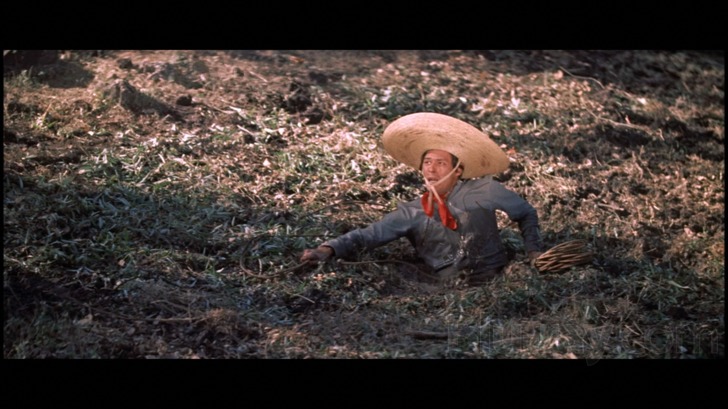
In town "Jimmy" gets into a fight with "Enrique's" over "Sarita".

"Pancho" leaves working for "Sarita" and goes to help "Jimmy". Who, like "Sarita", is very kind to him. Next, with "Panchito", the father and so go to a deserted farm house at the foot of the swamps and the "Hollow Mountain". "Pancho" wants to prove to both "Sarita" and "Jimmy" that he's not just a drunk by finding the cause of the cattle deaths.
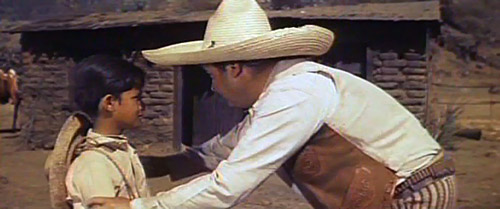
Telling "Panchito" to wait for him at the farm house, "Pancho" enters the swamp and hears a noise, looks up to see the "Beast", but all the audience sees is a shadow across the face of "Pancho" as he is killed. "Panchito" can not locate his father and goes back to "Jimmy" and "Felipe's" ranch and tells them he is missing. The two ranchers enter the swamp, but only find "Pancho's" hat and presume he got into the quicksand. They decide not to tell the boy and when they return. The two tell him they couldn't find his father and take "Panchito" to "Sarita's" to stay.
There a depressed and worried "Panchito" wants to look for his father, but the maid tells him that his father is dead. She watches the boy take a horse and ride off and tells "Sarita".
"Sarita" goes
to the abandoned house and to find "Panchito". Finally, "The Beast of Hollow
Mountain" makes his entrance chasing them into the house and starting to
eat what's left of the roof.
Returning to "A Century of Stop Motion Animation", paged 164, is the following entry concerning the Allosaurus:.
Returning to "A Century of Stop Motion Animation", paged 164, is the following entry concerning the Allosaurus:.
The models had originally been built by Marcel Delgado (see above photo) for O'Brien's abandoned Gwangi protect and the animation of the allosaurus was executed by Jack Rabin and Louis DeWitt, who used both a replacement technique and the more conventional and versatile articulate model animation.
The work of the "Visual
Effects" team of Jack Rabin and Louis DeWitt include
five horror-science fiction entries in 1957, These are "The
Pharaoh's Curse", "Kronos", "Monster from Green
Hell", "The Unknown Terror" and Roger Corman's,
love this complete title, "The Saga of the Viking Women and Their
Voyage to the Waters of the Great Sea Serpent".



"Jimmy" rides up and starts shooting at the Allosaurus and distracts it allowing "Sarita" and "Panchito" to get out of the house. They ride away for help as "Enrique" and his mean arrive and start shooting at "Jimmy", but the dinosaur now sees the other and attacks.
"Jimmy" saves "Enrique" and the two men get into a crevice in some rocks, but the Allosaurus is able to get and eat "Enrique".




"Sarita" rides up with help from the town and "Jimmy" gets to safety as the Allosaurus now goes after some cattle.
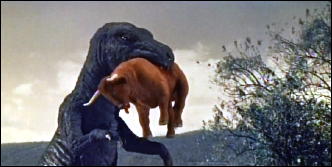
"Jimmy" has a plan to lure the dinosaur into the swamps and the quick sand.
Swinging on a robe tied to a tree he forces the dinosaur into the quick sand. It's shot at by the others and the Allosaurus slowly sinks out of sight to its death,

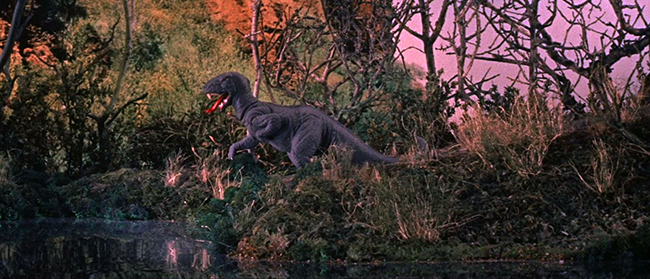



It would be 13 years before Willis O'Brien's "Gwangi" was heard from again and this time by Ray Harryhausen and his partner Charles H. Schneer.
I'll let Ray tell my readers what Obie's original script was like. This is found on pages 204 and 205 of "Ray Harryhausen An Animated Life":
I spent several hours several hours rummaging through the garage of my Palasades House (Pacific Palasades, California), eventually finding the script (Given to him in 1942), where upon I sat down to read it. After twenty-five years, I was surprised that it stood up reasonably well, although it has to be said that sections of it were too slow for modern audiences.
The T.J. Breckenridge and Co. Rodeo (the T.J. of the title being a woman) has arrived at the small desert town of Zenith, which is on the edge of "The Badlands". Also newly arrived is an "old friend" of T.J., Tuck Kirby. Mr. Carson, the curator of Zenith's curio museum, shows Tuck and other rodeo cowboys fossils of dinosaurs, and Charlie, a Navajo Indians, tells Tuck about a heard of Lilliputian horses, which are suppose to exist in the Badlands. Tuck decides to find the heard for the rodeo and is told by Charlie,... 'go due east. After three days you will sight a landmark called The Sentinel of Stones, beyond the dead forest and the river of lava'. Deep inside the Badlands, Tuck, T.J. and the rodeo cowboys find the Sentinel, a huge rock column, near the top of which they see a strange bat-like creature. In a chasm or canyon, they find the midget horses and the heard leads the explorers through a fissure entrance into a valley which Charlie has called 'The Valley of the Ancients'. Out of the sky swoops a pterodactyl and picks up one of the cowboys but due to the weight it falls back to the ground where Tuck kills it. Gwangi a massive allosaurus, appears and begins to eat the dead pterodactyl. The cowboys try to rope the massive creature but it breaks free and fights a triceratops which it kills. Chasing the cowboys Gwangi gets himself trapped in the fissure where he is knocked out by a rock fall. Returning to Zenith, the rodeo announces a new show, with a live dinosaur. The world's press arrives but Gwangi breaks free of his cage, killing some lions and devastating the town. Tuck manages to lead Gwangi to a rock ledge over a canyon, and T.J. drives a car into him, sending him over the cliff and into the abyss.
Returning to England with the script. I showed it to Charles, who also felt that the story had potential for an action adventure, Once we had obtained the rights, I began work on eight key sequence drawings------
THE VALLEY OF GWANGI premiered in Detroit, Michigan on June 11, 1969

The Charles H. Schneer and Ray Harryhausen production was directed by James "Jim" O'Connolly. By this time the Brimingham, West Midlands, England director had seven of his ten directorial positions completed. One of which was several episodes of the 1962 through 1969 Roger Moore television series "The Saint". Not to say O'Connolly wasn't involved with motion pictures. By this time he had also produced 40 feature films in the U.K. Including writing eleven screenplays.
The screenplay was written by William Bast. Bast was an "Edgar Award" winner. Named for writer Edgar Allan Poe, the award is presented by the "Mystery Writers of America" founded in 1945. He was also the first person to write a biography of James Dean, The two had been room mates while attending drama classes at U.C.L.A. Until "The Valley of Gwangi", William Bast, had only written television scripts and he returned afterwards to that medium.
Julian More wrote what is listed as "additional material" for the film. Between 1958 and 1981, More only wrote eight feature films. However, between 1958 and 2009 he wrote music for ten feature films. Including the song "Our Language of Love" for the Jack Lemmon and Shirley MacLaine 1963 "Irma la Douce".
Willis H. O'Brien (earlier film project "Gwangi")
(uncredited)
The six leading actors:
James Franciscus portrayed "Tuck Kirby". Televisions "Mr Novak", 1963 through 1965, had been acting on television since 1958. After starting film acting with 1957's forgotten juvenile delinquent motion picture crime drama "Four Boys and a Gun. 1969's "The Valley of Gwangi" was just Franciscus' fourth motion picture.
Gila Golan portrayed "T.J.
Breckenridge". Golan was an Israeli actress whose voice had to be dubbed because of her thick accent. Schneer and Harryhausen didn't want her, but Warner Brothers did and they brought the majority of the money for the film. Gila Golan had been in director Stanley Kramer's 1965 "Ship of Fools" and had third billing in the James Coburn spoof of "James Bond" the 1966 "Our Man Flint".


Above James Franciscus and Gila Golan.
Richard Carlson portrayed "Champ Connors". The previous year Richard Carlson had been in producer George Pal's "The Power". My article on the actor associated with two 3-D classics 1953's "It Came from Outer Space" and 1954's "The Creature from the Black Lagoon":
"Richard Carlson the Academic Turned Actor" will be found at:
http://www.bewaretheblog.com/2015/08/richard-carlson-academic-turned-actor.html
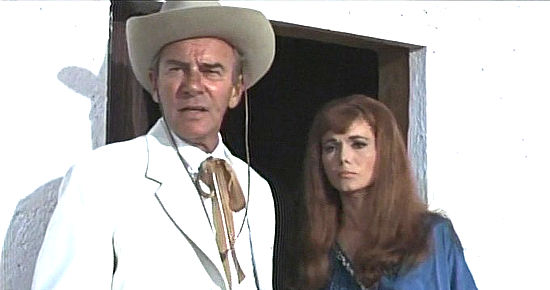
Above Richard Carlson and Gila Golan.
Laurence Naismith portrayed "Professor Bromley". In 1958 Naismith was the Captain of the Titanic in "A Night to Remember", in 1960 he was in the original "Village of the Damned", he was the ship builder "Argos" in Ray Harryhausen's 1963 "Jason and the Argonauts" and in 1967 he was "Merlin" in the motion picture musical based upon the Broadway Play "Camelot".
Laurence Naismith portrayed "Professor Bromley". In 1958 Naismith was the Captain of the Titanic in "A Night to Remember", in 1960 he was in the original "Village of the Damned", he was the ship builder "Argos" in Ray Harryhausen's 1963 "Jason and the Argonauts" and in 1967 he was "Merlin" in the motion picture musical based upon the Broadway Play "Camelot".
Freda Jackson portrayed "Tia Zorina--the Witch". In 1944 Jackson was in Sir Lawrence Olivier's version of William Shakespeare's "Henry V", in 1960 she was in Hammer Films "Brides of Dracula", and in 1965 Freda Jackson co-starred with Boris Karloff in H.P. Lovecraft's "Die Monster, Die".
Gustavo Rojo portrayed "Carlos dos Orsos". Rojo was born in Uruguay and made motion pictures in Spain, Italy and West Germany.
_021.jpg)
The Revised Willis O'Brien Story:
The setting was moved to Mexico and the rodeo became a Wild West Show in financial trouble. "Tuck Kirby" went from a friend of "T.J. Breckenridge" in Obie's story to her ex-lover in Harryhausen's. He also left for "Buffalo Bill's Wild West Show" and has returned to buy "T.J.'s" trick riding horse and the entire show, if possible for "Buffalo Bill".
_008.jpg)
"T.J." has an ace up her sleeve to save her show. She has a tiny horse named "El Diablo" which she shows "Tuck". Instead of a Navajo knowing of the "Valley of the Ancients". It is "Carlos" who brought the horse tp "T.J."and violated his gypsy code of guarding the "Forbidden Valley".
There is a British paleontologist named "Professor Bromley" that "Tuck" takes to see the horse.

Above "Tuck", "Bromley" and a young Mexican boy who befriends "Tuck" named "Lope". The "Emilio" of this screenplay without a bull.
"Professor Bromley" confirms that "El Diablo" is a prehistoric horse called a Eohippus that shouldn't be alive. "Champ Connors" manages the Wild West Show and is upset that "Tuck's" returned, because he blames him for leaving "T.J." and breaking her heart. He's like a father to her.
The gypsy's steal the Eohippus to free it and "Bromley" follows it to the herd.
_017.jpg)
"Tuck Kirby" goes after the professor, but "Carlos", knowing the truth, gets everyone else to thinks he stole the little horse. "T.J.", "Champ" and some of the cowboys follow "Carlos" to the entrance to the "Forbidden Valley". There they meet up with "Tuck Kirby" and immediately attack him for stealing the horse, but everyone cools down and they all enter the Valley.

Suddenly, a Pteranodon attacks as the Professor comes running towards the rodeo cowboys.



The Pteranodon picks up "Lope", but the boys weight pulls it down to Earth. This is a recreation of the Pteranodon scene with Raquel Welsh in Ray's 1966 "One Million Years B.C." except it's not over a river, but desert. With the Pteranodon on the ground the rodeo cowboys get it and "Carlos" kills the reptile by twisting its neck.
_022.jpg)
Then an Ornithomimus appears and the cowboys start to chase it, but a Tyrannosaurus, not a Allosaurus as in Obie's original, called by the gypsies "Gwangi", comes from behind a hill and kills the smaller dinosaur.


The Tyrannosaurus kills the Ornithomimus as it sees "Professor Bromley" and the others. The meat eating dinosaur starts to go after them, but a Styracosaurus attacks "Gwangi" and drives it away. However, the Tyrannosaurus picked up the dead Pteranodon before leaving.


Right out of the 1925 "The Lost World", the group takes refuge in a large cave and are attacked by "Gwangi".

_032.jpg)

The Styracosaurus returns and kills "Carlos".
We now reach the point in "The Valley of Gwangi" in which Ray Harryhausen has come full circle to Obie's original screenplay. It began with a plan for cowboys to rope an Allosaurus, moved to cowboys roping a Giant Gorilla and back to cowboys roping a Tyrannosaurus as they capture "Gwangi" for the "T.J. Breckenridge Wild West Show".

The captured "Gwangi" is taken to the city and the plan is to use it as a major attraction.
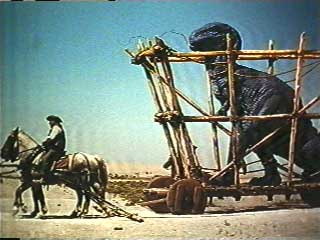
.
However, "Zorina" has other plans and wants one of the gypsies to release the dinosaur. So, she believes it will return to the "Forbidden Valley".

The grand stands are packed as they dwarf gypsy sneaks into the cage area with "Gwangi". Then everything goes wrong and the dwarf is killed.
_042.jpg)
When the cover over "Gwangi's" cage is lifted for the audience to see the dinosaur. Instead, they see it eating the gypsy and then escaping causing blind panic.
_043.jpg)
_044.jpg)
_045.jpg)
The cage splits open and part of it falls on "Professor Bromley" killing him and the crowd tramples "Zorina" to death. "Gwangi" now sees the Elephant that entertained the audience earlier.,
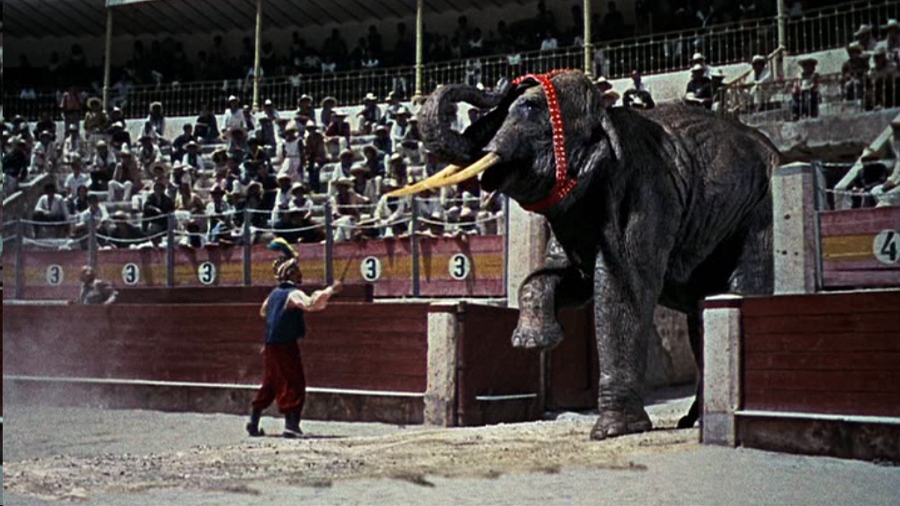
The dinosaur attacks and kills the Elephant. As Ray recreates a similar scene from 1957's "20 Million Miles to Earth".


The dinosaur now goes through a tunnel and out into the streets of the town, causing death and damage and eventually ending up in a church that is under construction.
_047.jpg)
_048.jpg)
In the church "Tuck" fights it and candles are turned over causing a massive fire. "Tuck" gets out, but "Gwangi" is burned to death.
_049.jpg)
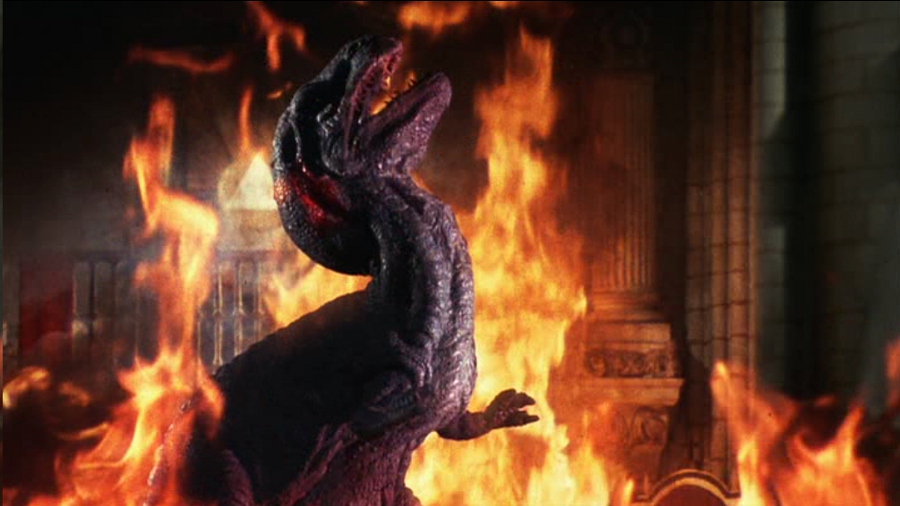
_050.jpg)
Mention the name of Willis Harold O'Brien and the 1933 film classic "King Kong" always comes up first. His legacy to the art of Stop Motion Animation included 1933's "Son of Kong", 1935's "SHE" and "The Last Days of Pompeii" and 1959's "Behemoth, the Sea Monster" aka: "The Giant Behemoth".
RIP Obie!
Gustavo Rojo portrayed "Carlos dos Orsos". Rojo was born in Uruguay and made motion pictures in Spain, Italy and West Germany.
_021.jpg)
The Revised Willis O'Brien Story:
The setting was moved to Mexico and the rodeo became a Wild West Show in financial trouble. "Tuck Kirby" went from a friend of "T.J. Breckenridge" in Obie's story to her ex-lover in Harryhausen's. He also left for "Buffalo Bill's Wild West Show" and has returned to buy "T.J.'s" trick riding horse and the entire show, if possible for "Buffalo Bill".
_008.jpg)
"T.J." has an ace up her sleeve to save her show. She has a tiny horse named "El Diablo" which she shows "Tuck". Instead of a Navajo knowing of the "Valley of the Ancients". It is "Carlos" who brought the horse tp "T.J."and violated his gypsy code of guarding the "Forbidden Valley".
There is a British paleontologist named "Professor Bromley" that "Tuck" takes to see the horse.

Above "Tuck", "Bromley" and a young Mexican boy who befriends "Tuck" named "Lope". The "Emilio" of this screenplay without a bull.
"Professor Bromley" confirms that "El Diablo" is a prehistoric horse called a Eohippus that shouldn't be alive. "Champ Connors" manages the Wild West Show and is upset that "Tuck's" returned, because he blames him for leaving "T.J." and breaking her heart. He's like a father to her.
The gypsy's steal the Eohippus to free it and "Bromley" follows it to the herd.
_017.jpg)
"Tuck Kirby" goes after the professor, but "Carlos", knowing the truth, gets everyone else to thinks he stole the little horse. "T.J.", "Champ" and some of the cowboys follow "Carlos" to the entrance to the "Forbidden Valley". There they meet up with "Tuck Kirby" and immediately attack him for stealing the horse, but everyone cools down and they all enter the Valley.

Suddenly, a Pteranodon attacks as the Professor comes running towards the rodeo cowboys.



The Pteranodon picks up "Lope", but the boys weight pulls it down to Earth. This is a recreation of the Pteranodon scene with Raquel Welsh in Ray's 1966 "One Million Years B.C." except it's not over a river, but desert. With the Pteranodon on the ground the rodeo cowboys get it and "Carlos" kills the reptile by twisting its neck.
_022.jpg)
Then an Ornithomimus appears and the cowboys start to chase it, but a Tyrannosaurus, not a Allosaurus as in Obie's original, called by the gypsies "Gwangi", comes from behind a hill and kills the smaller dinosaur.


The Tyrannosaurus kills the Ornithomimus as it sees "Professor Bromley" and the others. The meat eating dinosaur starts to go after them, but a Styracosaurus attacks "Gwangi" and drives it away. However, the Tyrannosaurus picked up the dead Pteranodon before leaving.


Right out of the 1925 "The Lost World", the group takes refuge in a large cave and are attacked by "Gwangi".

_032.jpg)

The Styracosaurus returns and kills "Carlos".
We now reach the point in "The Valley of Gwangi" in which Ray Harryhausen has come full circle to Obie's original screenplay. It began with a plan for cowboys to rope an Allosaurus, moved to cowboys roping a Giant Gorilla and back to cowboys roping a Tyrannosaurus as they capture "Gwangi" for the "T.J. Breckenridge Wild West Show".

The captured "Gwangi" is taken to the city and the plan is to use it as a major attraction.

.
However, "Zorina" has other plans and wants one of the gypsies to release the dinosaur. So, she believes it will return to the "Forbidden Valley".

The grand stands are packed as they dwarf gypsy sneaks into the cage area with "Gwangi". Then everything goes wrong and the dwarf is killed.
_042.jpg)
When the cover over "Gwangi's" cage is lifted for the audience to see the dinosaur. Instead, they see it eating the gypsy and then escaping causing blind panic.
_043.jpg)
_044.jpg)
_045.jpg)
The cage splits open and part of it falls on "Professor Bromley" killing him and the crowd tramples "Zorina" to death. "Gwangi" now sees the Elephant that entertained the audience earlier.,

The dinosaur attacks and kills the Elephant. As Ray recreates a similar scene from 1957's "20 Million Miles to Earth".

The dinosaur now goes through a tunnel and out into the streets of the town, causing death and damage and eventually ending up in a church that is under construction.
_047.jpg)
_048.jpg)
In the church "Tuck" fights it and candles are turned over causing a massive fire. "Tuck" gets out, but "Gwangi" is burned to death.
_049.jpg)

_050.jpg)
Mention the name of Willis Harold O'Brien and the 1933 film classic "King Kong" always comes up first. His legacy to the art of Stop Motion Animation included 1933's "Son of Kong", 1935's "SHE" and "The Last Days of Pompeii" and 1959's "Behemoth, the Sea Monster" aka: "The Giant Behemoth".
RIP Obie!





No comments:
Post a Comment